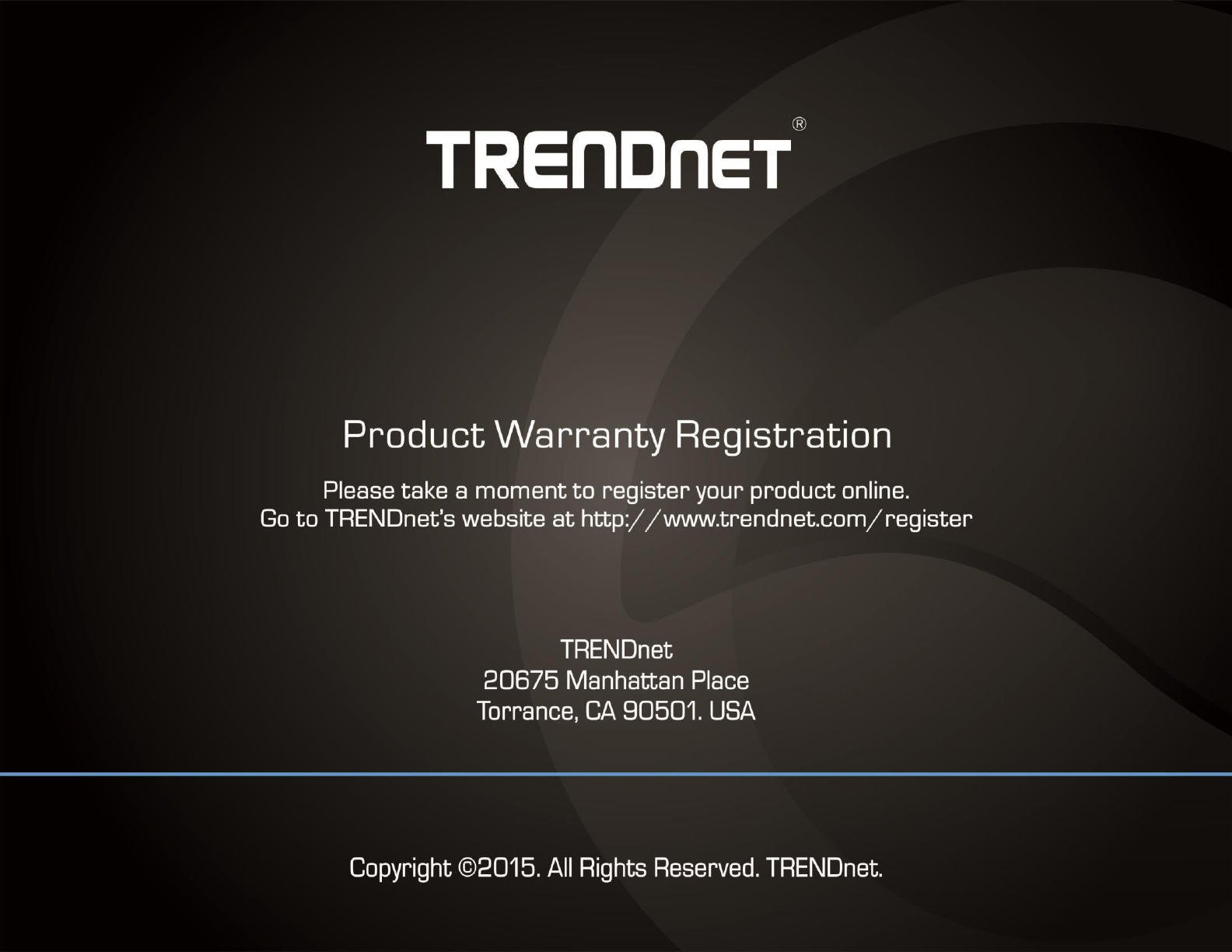TRENDNET TEW755AP N300 PoE Access Point User Manual test 3
TRENDNET, Inc. N300 PoE Access Point test 3
TRENDNET >
Users Manual
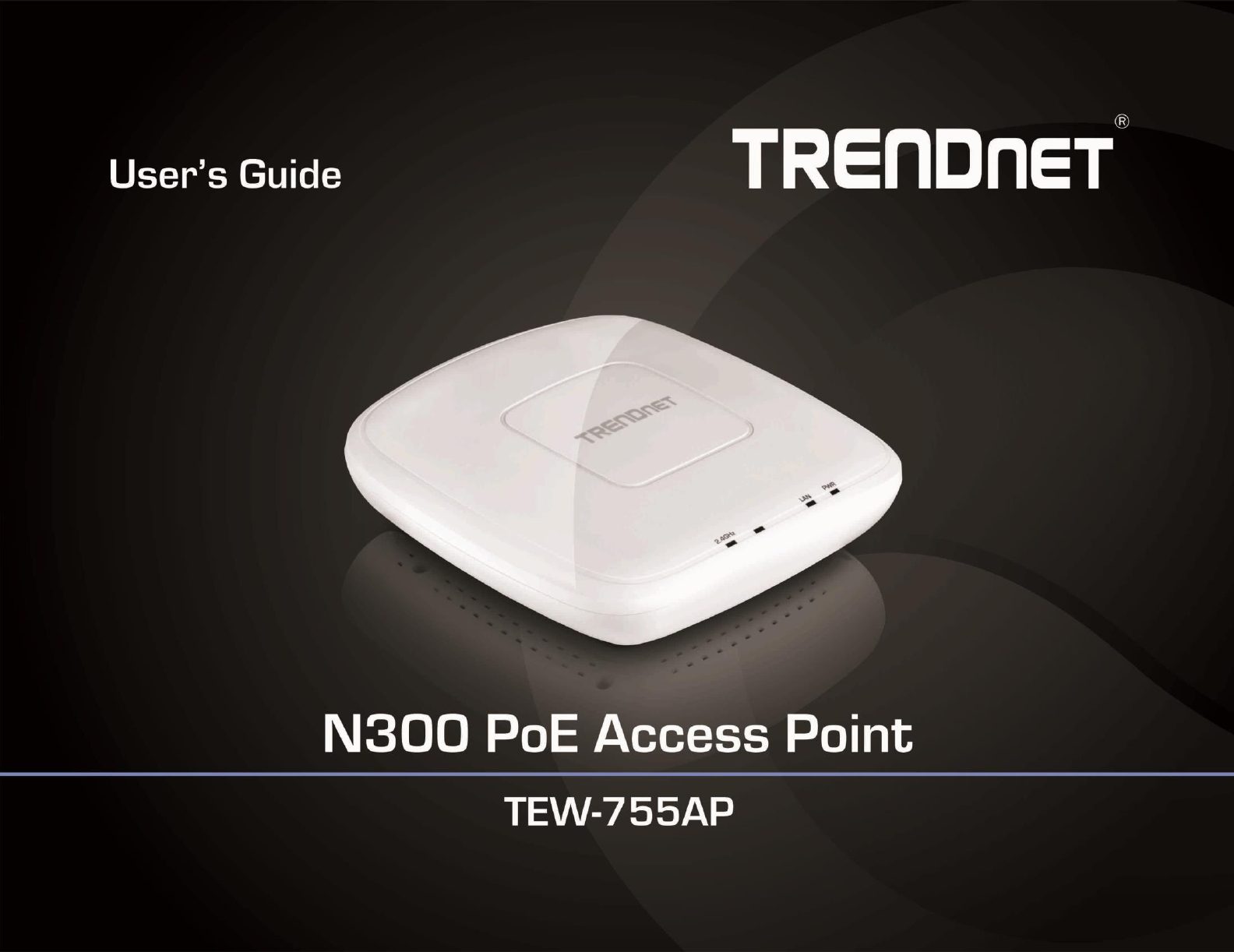
TRENDet User’s Guide
Cover Page

© Copyright 2015 TRENDnet. All Rights Reserved.
TRENDet User’s Guide
Table of contents
2
Table of Contents
Table of Contents ............................................................................ 2
Product Overview ........................................................................... 4
Package Contents .......................................................................................................... 4
Features ......................................................................................................................... 4
Product Hardware Features........................................................................................... 5
Application Diagram ...................................................................................................... 6
Connect wireless devices to your access point .............................................................. 7
Getting Started ............................................................................... 7
Steps to improve wireless connectivity ......................................................................... 8
Connect wireless devices to your access point .............................................................. 9
Configuration .................................................................................. 9
Wireless Networking and Security ................................................. 11
How to choose the type of security for your wireless network .................................. 11
Secure your wireless network ..................................................................................... 13
Connect wireless devices using WPS ........................................................................... 15
Advance configuration .................................................................. 16
Access the management page ..................................................................................... 16
Operating Modes ......................................................................................................... 17
Access Point .................................................................................. 18
Basic ............................................................................................................................. 18
Wireless Profile ............................................................................................................ 19
Wireless MAC filter ...................................................................................................... 19
Client Bridge ................................................................................. 20
Basic ............................................................................................................................. 20
Scan for wireless networks .......................................................................................... 20
WDS ............................................................................................. 21
WDS Link ...................................................................................................................... 22
Basic ............................................................................................................................. 22
Wireless Profile ............................................................................................................ 23
Repeater ....................................................................................... 24
Basic ............................................................................................................................. 24
Scan for wireless networks .......................................................................................... 24
Advanced wireless settings ......................................................................................... 25
Advanced Wireless ............................................................................................ 25
HT Physical Mode .............................................................................................. 25
Client Limit ......................................................................................................... 26
Band Steering .............................................................................................................. 26
Change your IP address ............................................................................................... 26
Create schedules ......................................................................................................... 26
Configure Spanning Tree ............................................................................................. 27
Set date and time ........................................................................................................ 27
Manage VLAN .............................................................................................................. 28
Traffic Shaping ............................................................................................................. 28
Enable SNMP ............................................................................................................... 28
Enable CLI .................................................................................................................... 29
LED Controls ................................................................................................................ 29
Maintenance & Monitoring ........................................................... 30
Reset to factory defaults ............................................................................................. 30
Backup and restore your configuration settings ......................................................... 30
Restart access point ..................................................................................................... 30
Upgrade your firmware ............................................................................................... 31
Configure log ............................................................................................................... 32
Test connectivity.......................................................................................................... 32

© Copyright 2015 TRENDnet. All Rights Reserved.
TRENDet User’s Guide
Table of contents
3
Check system information ........................................................................................... 32
Check connected wireless clients ................................................................................ 33
Status > IPv6 Status ..................................................................................................... 33
Software Controller utility ............................................................. 34
Installation ................................................................................................................... 34
Add and Delete Device ................................................................................................ 34
Device Settings ............................................................................................................ 35
Upgrade Firmware ....................................................................................................... 35
Load configuration ....................................................................................................... 36
Troubleshooting ............................................................................ 37
Appendix ...................................................................................... 38
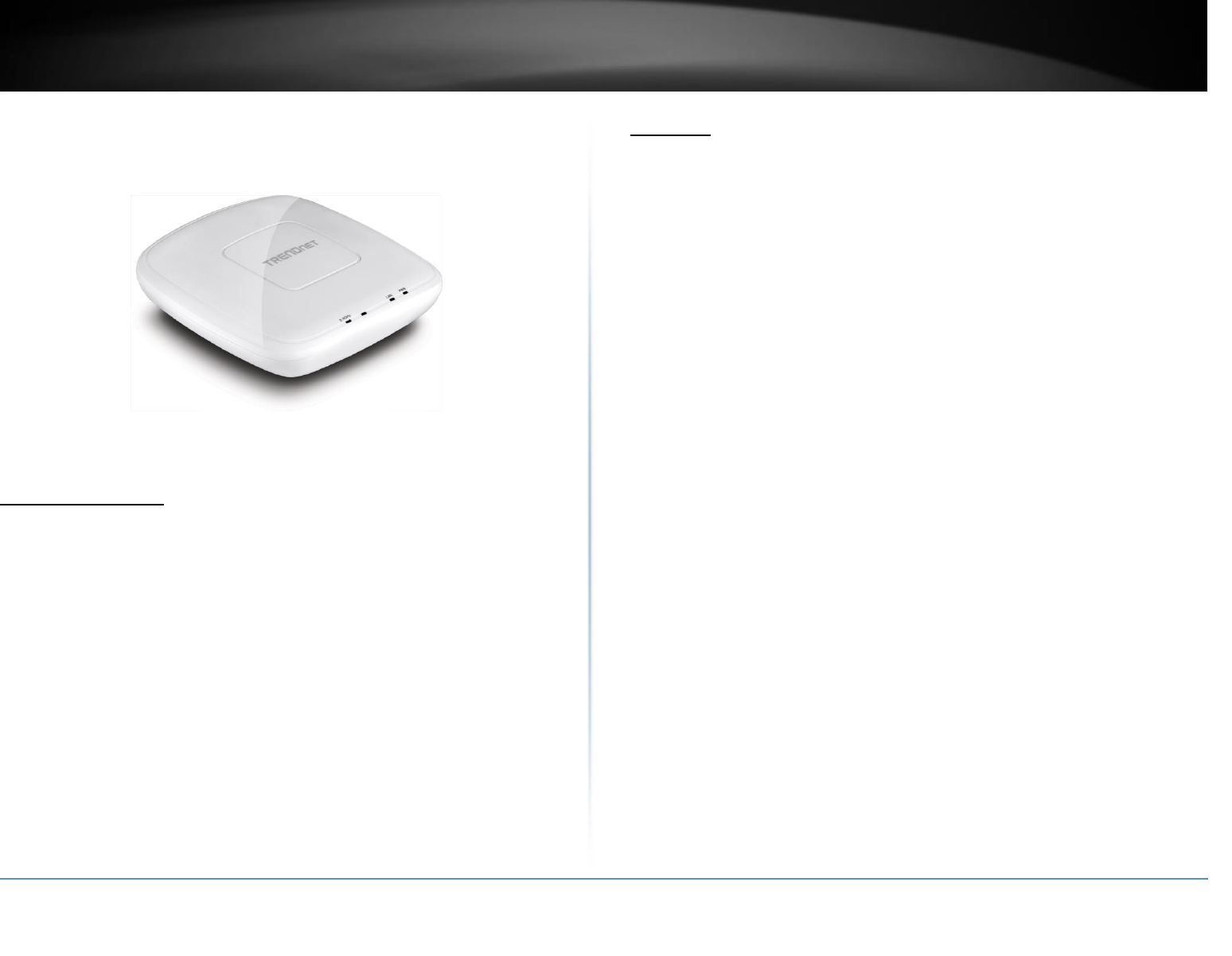
© Copyright 2015 TRENDnet. All Rights Reserved.
TRENDet User’s Guide
TEW-755AP
4
Product Overview
TEW-755AP
Package Contents
In addition to your router, the package includes:
TEW-755AP
5 ft. (1.5 m) network cable
CD-ROM Utilit ad Use’s Guide
Quick Installation Guide
Power adapter (12V DC, 1A)
Mounting bracket
If any package contents are missing or damaged, please contact the retail store, online
retailer, or reseller/distributor from which the product was purchased.
Features
TREΠDet’s high pefoae Π PoE Aess Poit, odel TEW-755AP,
supports Access Point (AP), Client, Wireless Distribution System (WDS) AP, WDS
Bridge, WDS Station, and Repeater modes. It generates a 300 Mbps WiFi N
network and features a Gigabit PoE port. The included Windows-based software
controller manages multiple TEW-755APs and reduces WiFi
management/troubleshooting time. A low profile housing blends into most
environments and a mounting plate eases installation.
Multi-Language
Multi-Language Interface: English, Spanish, French, German, and Russian
Power over Ethernet (PoE)
Saves remote location installation time and costs with Gigabit PoE
support (Optional power port for non-PoE installations)
WiFi N300
Low profile access point delivers proven WiFi N300
Multi-Mode Support
Supports Access Point (AP), Client, WDS AP, WDS Bridge, WDS Station,
and Repeater modes
Software Controller
The included Windows-based Software Controller manages multiple
TEW-755APs and reduces WiFi configuration, management, and
troubleshooting time
Gigabit Port
Gigabit PoE LAN port maintains high performance connections to the
wired network
Wireless Coverage
Extended wireless coverage with MIMO antenna technology
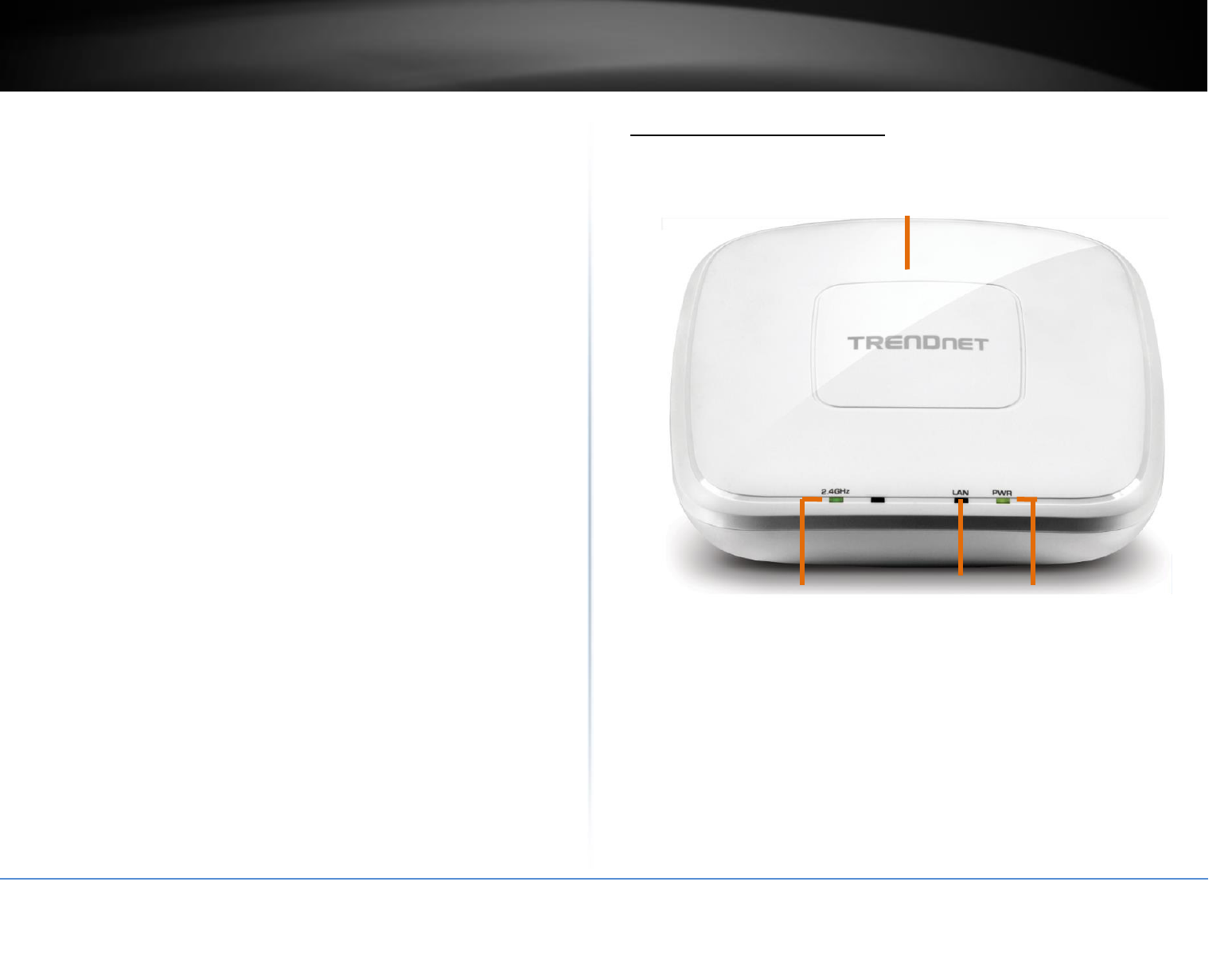
© Copyright 2015 TRENDnet. All Rights Reserved.
TRENDet User’s Guide
TEW-755AP
5
2.4GHz
LAN
PWR
Encrypted Wireless
Support for wireless encryption of up to WPA2
WiFi Traffic Shaping
Manage traffic allocation per VLAN
IPv6
IPv6 network support
Low Profile
Off white low profile housing blends into most environments
LED Control
Further reduce product visibility by turning off LED indicators
Mounting Plate
Mounting plate reduces installation time
*Maximum wireless signal rates are referenced from IEEE 802.11 theoretical
specifications. Actual data throughput and coverage will vary depending on
interference, network traffic, building materials and other conditions.
Product Hardware Features
Top View
2.4GHz: This LED indicator turns green when the wireless is enabled. The LED
indicator blinks during data transmission
LAN: This LED indicator turns green when the access point LAN port is connected.
The LED indicator blinks during data transmission
PWR: This indicator turns green when the device is powered.
Off white low profile housing
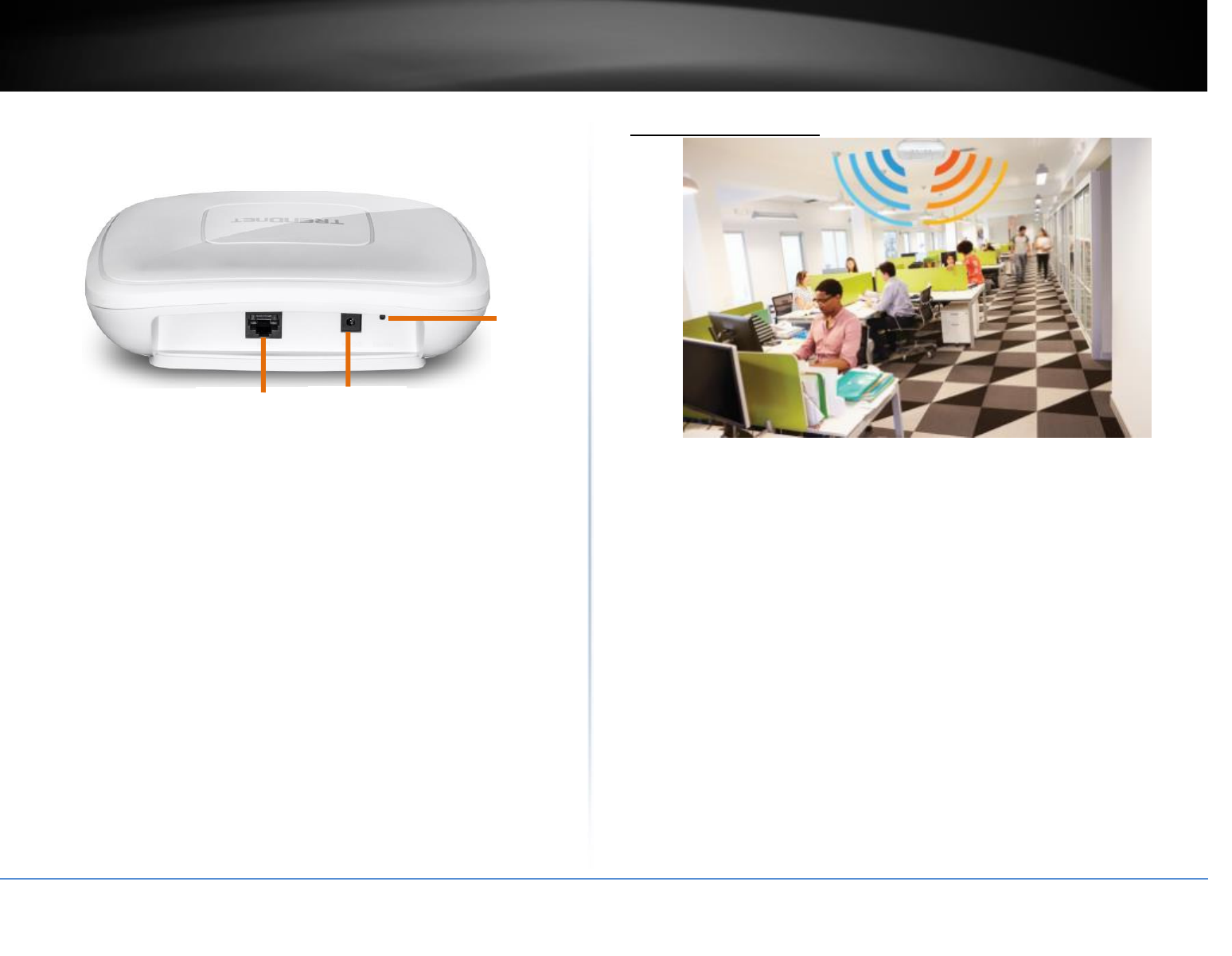
© Copyright 2015 TRENDnet. All Rights Reserved.
TRENDet User’s Guide
TEW-755AP
6
Reset
button
Front View
Gigabit port: Plug an Ethernet cable (also called network cables) from
your access point to your router and wired network devices.
Power port: Connect the power adapter from your access point power port to
an available power outlet.
Reset button: Use a sharp tool to press and hold this button for 10 seconds to
reset the access point.
Application Diagram
The access point provides 300 Mbps WiFi N combined with AP, Client, WDS and Repeater modes
support multiple applications.
Gigabit Port
Power port
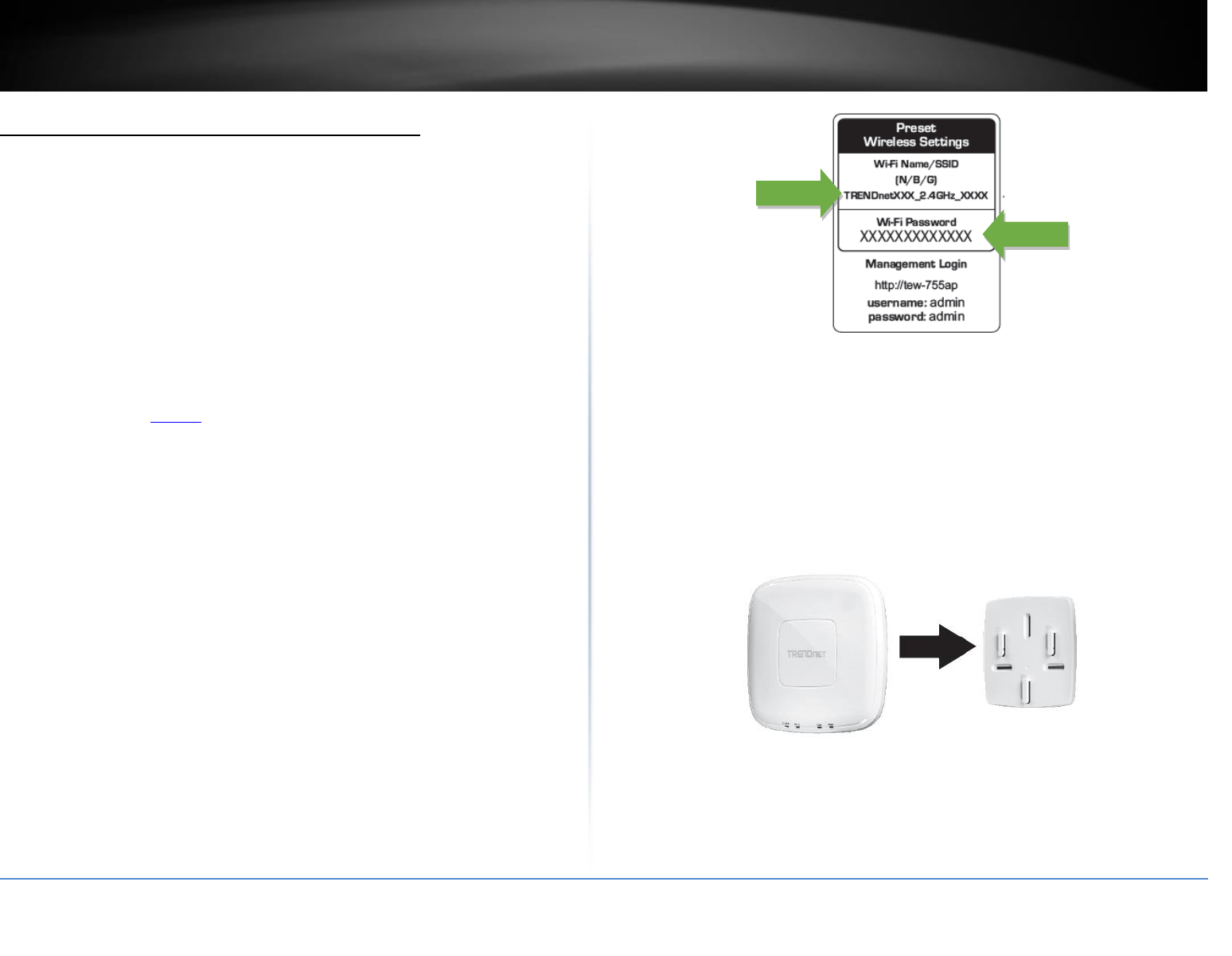
© Copyright 2015 TRENDnet. All Rights Reserved.
TRENDet User’s Guide
TEW-755AP
7
Connect wireless devices to your access point
A variety of wireless network devices can connect to your wireless network such as:
Wireless Laptop computers
Network media players
Wireless IP cameras
Smart Phones
Gaming Consoles
Internet enabled TVs
Each device may have its own software utility for searching and connecting to available
ieless etoks, theefoe, ou ust efe to the Use’s Maual/Guide of ou
wireless client device to determine ho to seah ad oet to this oute’s ieless
network.
“ee the Appedi o page 53 for general information on connecting to a wireless
network.
Getting Started
For a typical wireless setup at home or office when using the access point in AP mode,
please do the following:
Installation
1. Connect the power adapter to the power port of the access point. Or simply plug an
Ethernet cable on the access point to a PoE (Power over Ethernet) switch that
connects to your router or network.
2. If using the power adapter, plug an Ethernet cable to the access point and plug the
other end to your router or network.
3. Verify that all LEDs are on.
4. For your security, each TEW-755AP comes pre-encrypted with a unique WiFi Name
(SSID) and WiFi Password. You can find your device's SSID and WiFi password on the
white labels located on the device. Use this information to connect to the TEW-755AP
access point.
5. Verify your connection to you network by accessing the Internet. For advanced
configuration continue to the advanced sections of the user manual.
Mounting device
1. Remove the mount plate from the access point.
2. Place the mounting plate on the wall or ceiling where the device will be located and
mark the location of the screw holes. Ensure that the device has enough clearance to
slide on and off the mounting plate.
3. Drill out the marked holes and insert the plastic wall anchors in to the wall.
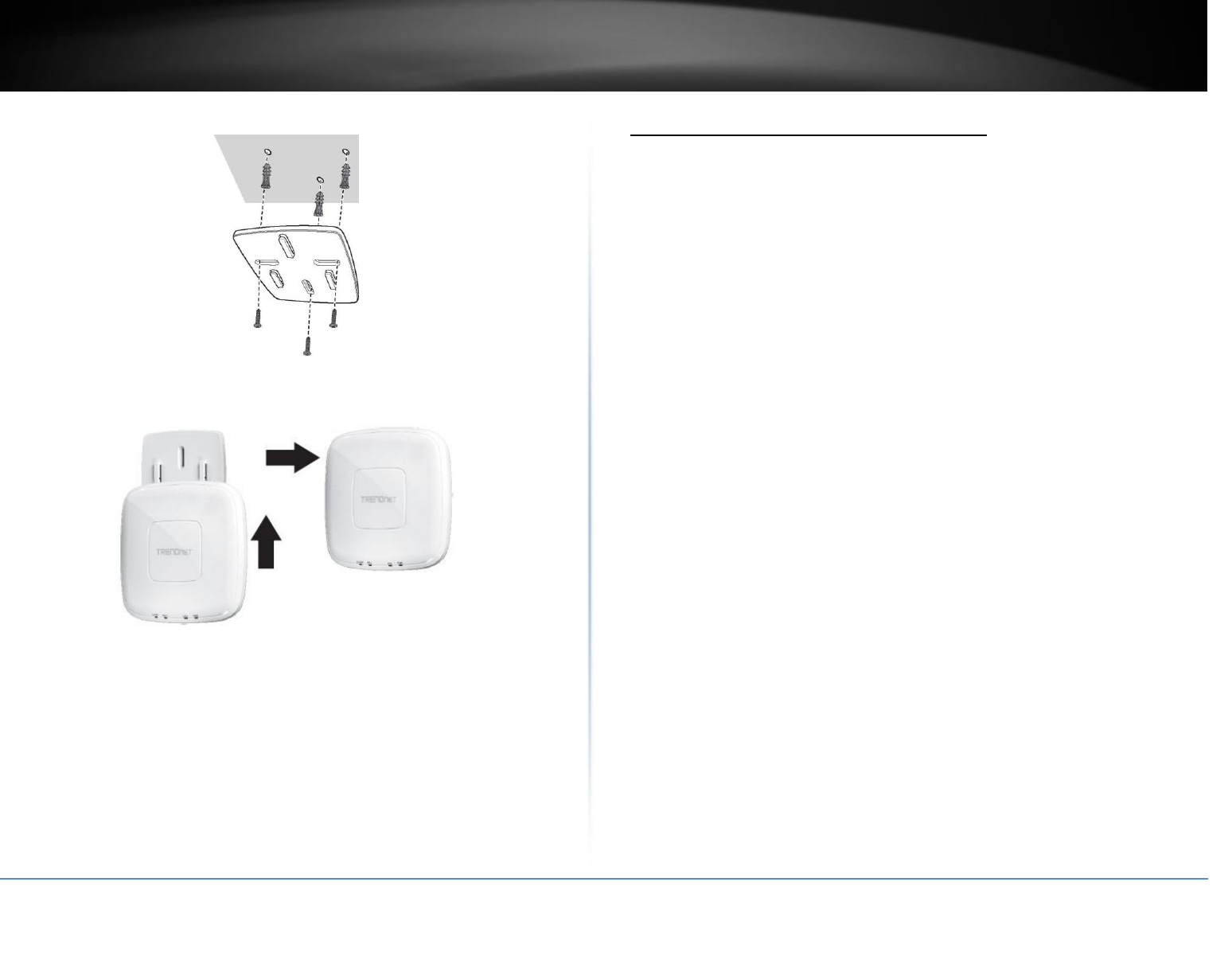
© Copyright 2015 TRENDnet. All Rights Reserved.
TRENDet User’s Guide
TEW-755AP
8
4. Secure the mounting plate using the screws that came with the device.
5. Place the access point on the mounting plate and slide to lock into position.
Steps to improve wireless connectivity
There are a number of factors that can impact the range of wireless devices. Follow
these tips to help improve your wireless connectivity:
1. Keep the number of obstructions to a minimum. Each obstruction can reduce the
range of a wireless device. Position the wireless devices in a manner that will
minimize the amount of obstructions between them.
a. For the widest coverage area, install your router near the center of your home, and
near the ceiling, if possible.
b. Avoid placing the router on or near metal objects (such as file cabinets and metal
furniture), reflective surfaces (such as glass or mirrors), and masonry walls.
c. Any obstruction can weaken the wireless signal (even non-metallic objects), so the
fewer obstructions between the router and the wireless device, the better.
d. Place the router in a location away from other electronics, motors, and fluorescent
lighting.
e. Ma eioetal aiales a affet the oute’s pefoae, so if ou
wireless signal is weak, place the router in several locations and test the signal
strength to determine the ideal position.
2. Building materials can have a large impact on your wireless signal. In an indoor
environment, try to position the wireless devices so that the signal passes through
less dense material such as dry wall. Dense materials like metal, solid wood, glass or
even furniture may block or degrade the signal.
3. Antenna orientation can also have a large impact on your wireless signal. Use the
ieless adapte’s site sue tool to deteie the est atea oietatio fo ou
wireless devices.
4. Interference from devices that produce RF (radio frequency) noise can also impact
your signal. Position your wireless devices away from anything that generates RF
noise, such as microwaves, radios and baby monitors.
If possible, upgrade wireless network interfaces (such as wireless cards in computers)
from older wireless standards to 802.11n. If a wirelessly networked device uses an older
standard, the performance of the entire wireless network may be slower. If you are still
experiencing low or no signal consider repositioning the wireless devices or installing
additional access points.
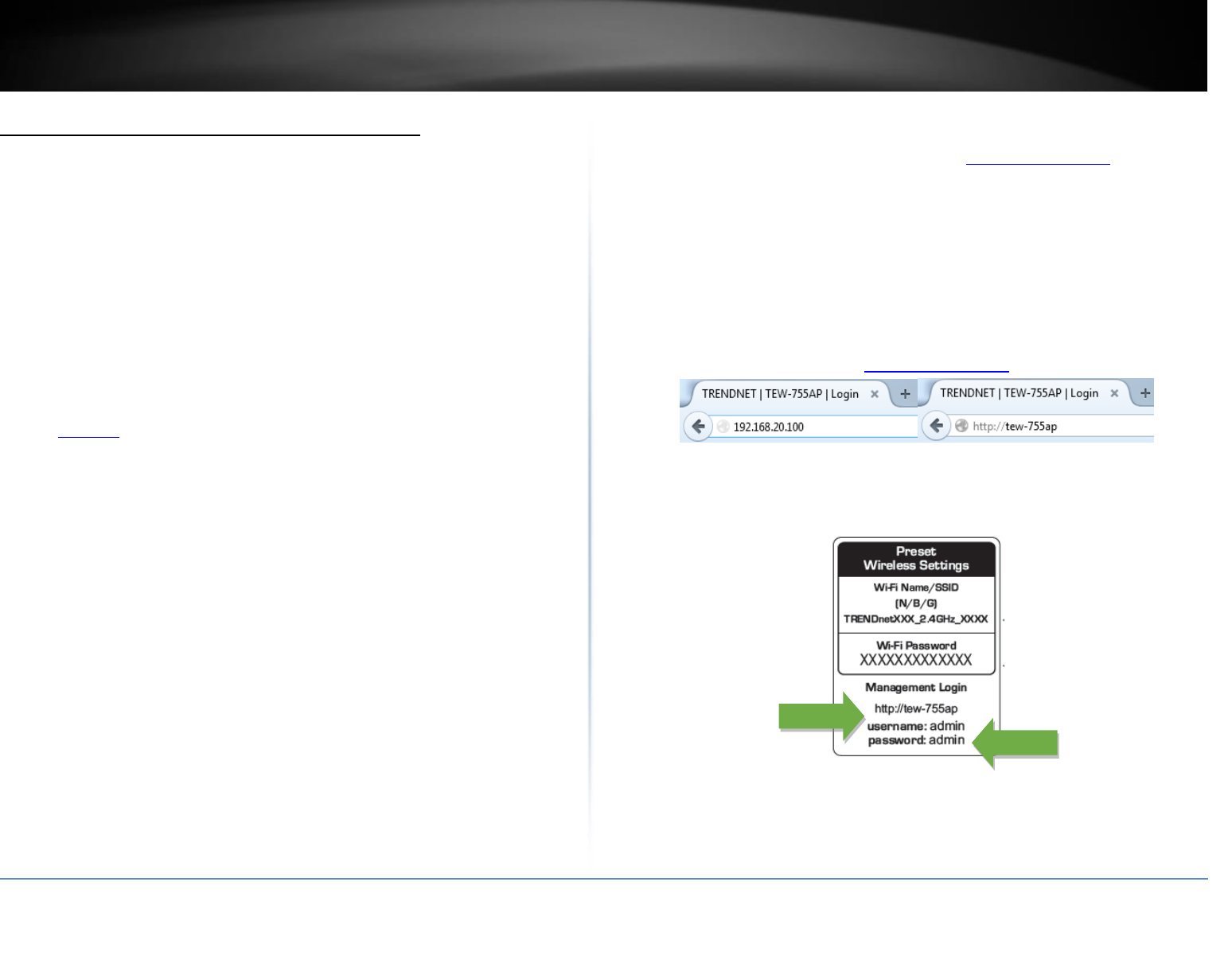
© Copyright 2015 TRENDnet. All Rights Reserved.
TRENDet User’s Guide
TEW-755AP
9
Connect wireless devices to your access point
A variety of wireless network devices can connect to your wireless network such as:
Gaming Consoles
Internet enabled TVs
Network media players
Smart Phones
Wireless Laptop computers
Wireless IP cameras
Each device may have its own software utility for searching and connecting to available
ieless etoks, theefoe, ou ust efe to the Use’s Maual/Guide of ou
ieless liet deie to deteie ho to seah ad oet to this oute’s ieless
network.
“ee the Appendix o page 63 for general information on connecting to a wireless
network.
Configuration
Note: The aess poit’s default aageet page http://192.168.10.100 is accessed
through the use of your Internet web browser (e.g. Internet Explorer, Firefox, Chrome,
Safai, ad Opea ad ill e efeeed feuetly i this Use’s Guide.
Before accessing the web-based management page, configure the IP address and
subnet mask of your computer to the following:
IP Address: 192.168.10.xxx
Subnet Mask: 255.255.255.0
1. Open your web browser (e.g. Internet Explorer, Firefox, Safari, Chrome, or Opera) and
go to http://tew-755ap or type in http://192.168.10.100.
2. Enter the default user name and password and then click Login. You can find your
device's SSID and WiFi password on the white labels located on the device. Use this
information to connect to the TEW-755AP access point.
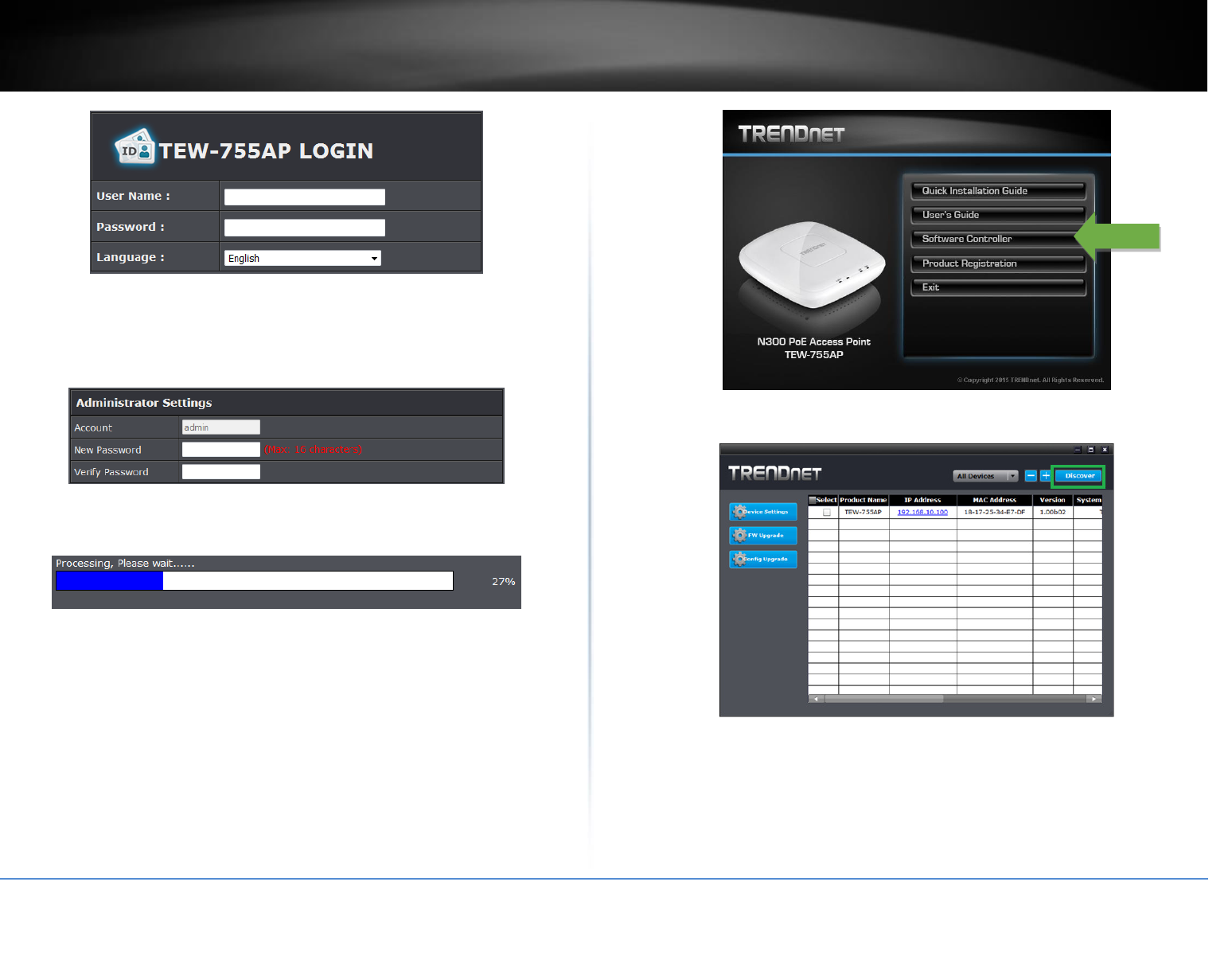
© Copyright 2015 TRENDnet. All Rights Reserved.
TRENDet User’s Guide
TEW-755AP
10
Wizard
1. For the first time logging into the device the setup wizard will start automatically.
2. Your security the first step is to change the login password of the access point. Enter
your new login password and click OK.
3. Your new password settings will be applied and you will be redirected to the login
screen. You will need to use the new login password to proceed.
Using the utility
For additional information on the utility please go to software controller section.
1. Insert the CD ROM included with the access point.
2. Click on Software controller to install the utility.
3. Once the utility is installed click on Discover to refresh the list of access points.
4. Select the access point you want to configure.
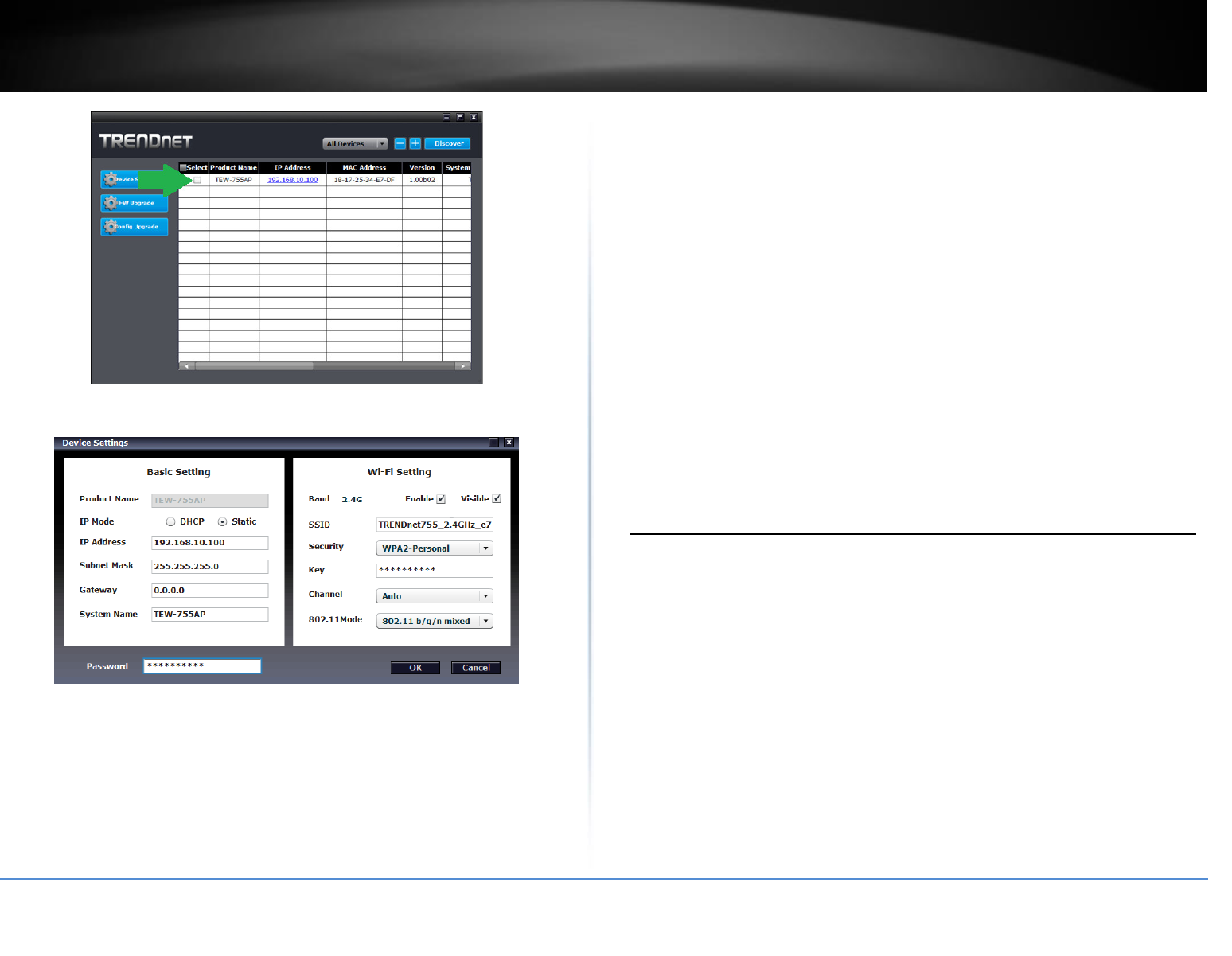
© Copyright 2015 TRENDnet. All Rights Reserved.
TRENDet User’s Guide
TEW-755AP
11
5. Click on Device settings to configure the access point.
Product Name: Displays the device model
IP Mode: Select the IP mode to apply on the device
o DHCP: Select this option to allow the device to receive IP address from your
DHCP server
o Static: Select this option to manually set the IP address of the device
IP Address: Enter the IP address to assign to the device
Subnet Mask: Enter the subnet mask to assign to the device
Gateway: Enter the gateway IP address to assign to the device
System Name: Assign name of the device to help distinguish between similar
devices
Band: Select on the pull down menu the wireless interface to configure
Enable: Select this option to enable the selected wireless interface
Visible: Select this option to wireless broadcast the selected wireless interface
SSID: Enter the SSID (Wireless Network Name) of the selected wireless interface
Security: Select the wireless encryption security for to assign the selected
wireless interface
Key: Enter the wireless encryption security key or password
Channel: Select the wireless channel of the selected wireless interface
802.11 Mode: Select the 802.11 mode of the selected wireless interface
Password: Enter the login password of the device and click OK to save settings.
Wireless Networking and Security
How to choose the type of security for your wireless network
Setting up wireless security is very important. Leaving your wireless network open and
unsecure could expose your entire network and personal files to outsiders. TRENDnet
recommends reading through this entire section and setting up wireless security on your
new router.
There are a few different wireless security types supported in wireless networking each
having its own characteristics which may be more suitable for your wireless network
taking into consideration compatibility, performance, as well as the security strength
along with using older wireless networking hardware (also called legacy hardware).
It is strongly recommended to enable wireless security to prevent unwanted users from
accessing your network and network resources (personal documents, media, etc.).
In general, it is recommended that you choose the security type with the highest
strength and performance supported by the wireless computers and devices in your
network. Please review the security types to determine which one you should use for
your network.
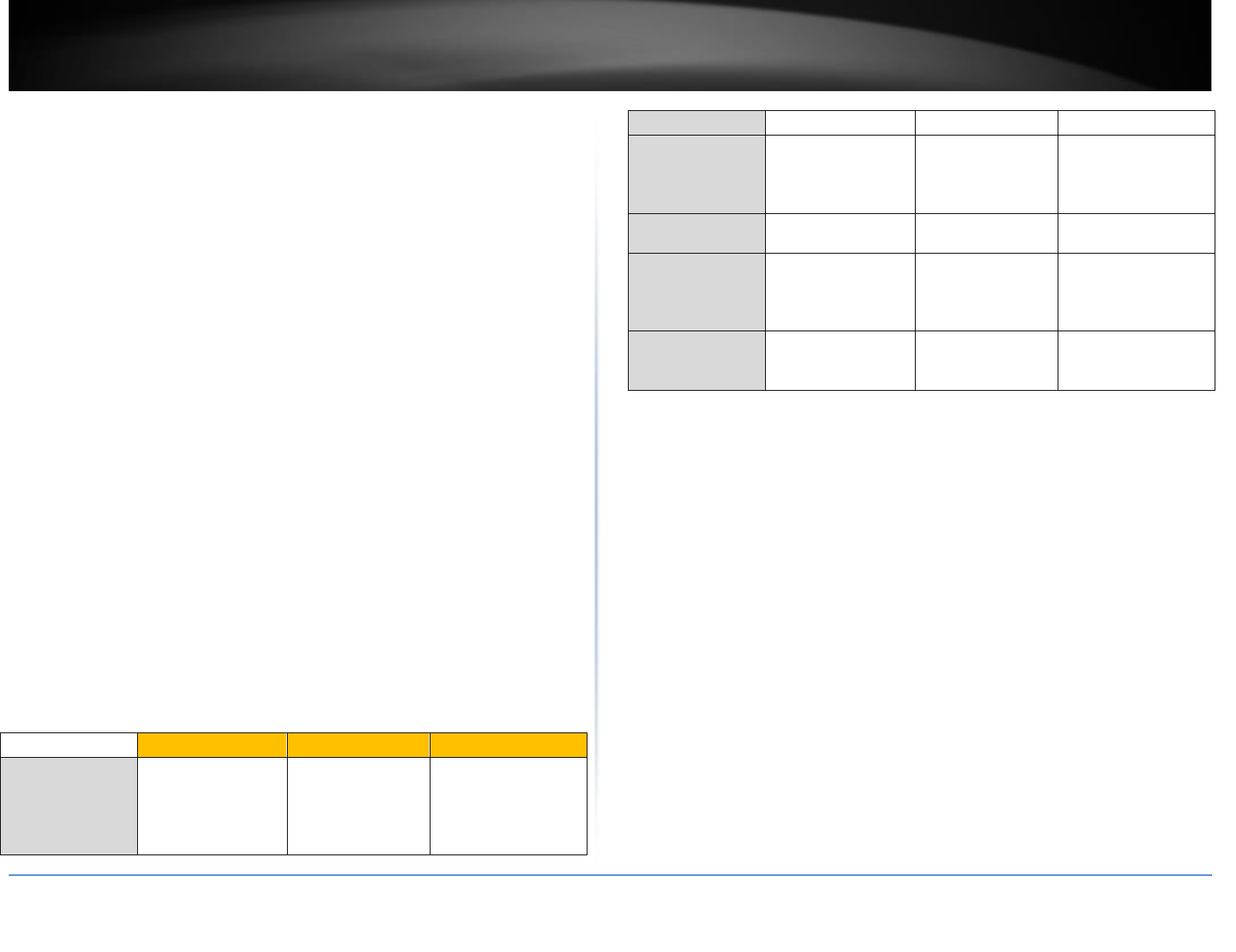
© Copyright 2015 TRENDnet. All Rights Reserved.
TRENDet User’s Guide
TEW-755AP
12
Wireless Encryption Types
WEP: Legacy encryption method supported by older 802.11b/g hardware. This is
the oldest and least secure type of wireless encryption. It is generally not
recommended to use this encryption standard, however if you have old 802.11 b or
802.11g wireless adapters or computers with old embedded wireless cards(wireless
clients), you may have to set your router to WEP to allow the old adapters to
connect to the router.
Note: This encryption standard will limit connection speeds to 54Mbps.
WPA: This encryption is significantly more robust than the WEP technology. Much
of the older 802.11g hardware was been upgraded (with firmware/driver upgrades)
to support this encryption standard. Total wireless speeds under this encryption
type however are limited to 54Mbps.
WPA-Auto: This setting provides the router with the ability to detect wireless
devices using either WPA or WPA2 encryption. Your wireless network will
automatically change the encryption setting based on the first wireless device
connected. For example, if the first wireless client that connects to your wireless
network uses WPA encryption your wireless network will use WPA encryption. Only
when all wireless clients disconnect to the network and a wireless client with WPA2
encryption connects your wireless network will then change to WPA2 encryption.
Note: WPA2 encryption supports 802.11n speeds and WPA encryption will limit
your connection speeds to 54Mbps
WPA2: This is the most secure wireless encryption available today, similar to WPA
encryption but more robust. This encryption standard also supports the highest
connection speeds. TRENDnet recommends setting your router to this encryption
standard. If you find that one of your wireless network devices does not support
WPA2 encryption, then set your router to either WPA or WPA-Auto encryption.
Note: Check the specifications of your wireless network adapters and wireless
appliances to verify the highest level of encryption supported. Below is brief
comparison chart of the wireless security types and the recommended
configuration depending on which type you choose for your wireless network.
Security Standard
WEP
WPA
WPA2
Compatible
Wireless
Standards
IEEE 802.11a/b/g
(802.11n devices
will operate at
802.11g to connect
using this standard)
IEEE 802.11a/b/g
(802.11n devices
will operate at
802.11g to connect
using this
IEEE 802.11a/b/g/n
standard)
Highest
Performance
Under This
Setting
Up to 54Mbps
Up to 54Mbps
Up to 450Mbps (11n)
and up to 1.3Gbps
(11ac)*
Encryption
Strength
Low
Medium
High
Additional
Options
Open System or
Shared Key,
HEX or ASCII,
Different key sizes
TKIP or AES,
Preshared Key or
RADIUS
TKIP or AES,
Preshared Key or
RADIUS
Recommended
Configuration
Open System ASCII
13 characters
TKIP
Preshared Key
8-63 characters
AES
Preshared Key
8-63 characters
*Dependent on the maximum data rate supported by the device (150Mbps, 300Mbps,)
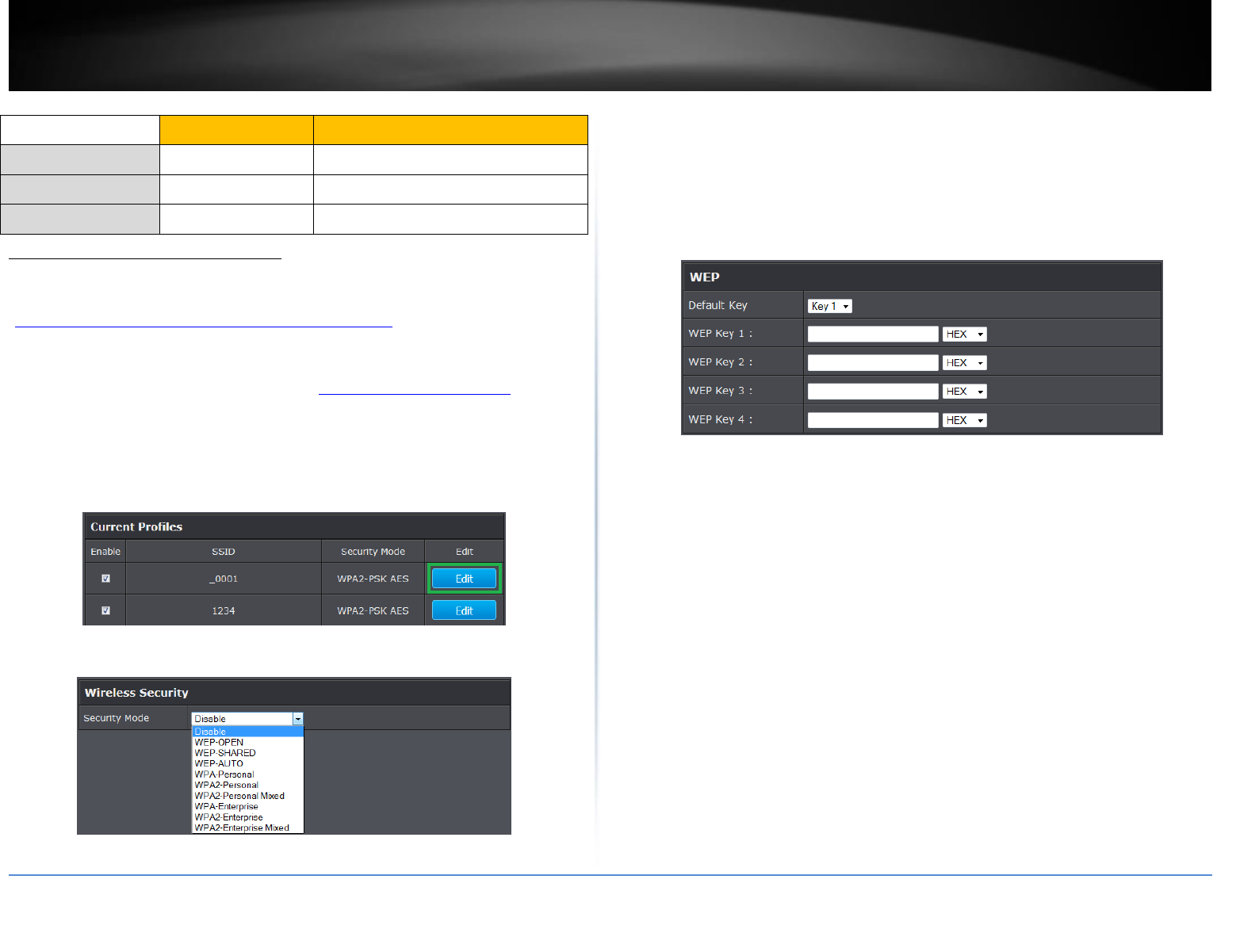
© Copyright 2015 TRENDnet. All Rights Reserved.
TRENDet User’s Guide
TEW-755AP
13
Secure your wireless network
Wireless Security
After you have determined which security type to use for your wireless network (see
How to choose the security type for your wireless network o page 12), you can set up
wireless security.
. Κog ito ou oute aageet page see Access the management page o page
16).
2. Click on the Wireless 2.4GHz
3. Underneath the basic wireless band section, you will see Wireless Network and all
your wireless network profiles will be listed.
4. Click on the Edit button next to the wireless profile you want to configure.
5. Select from the drop-down list to the wireless security to configure.
Selecting WEP-OPEN, WEP-SHARED: If selecting WEP (Wired Equivalent Privacy), please
review the WEP settings to configure and click Apply to save the changes.
Note: WPS functionality is not available when using WEP.
In the Security Mode drop-down list, select WEP-OPEN or WEP-SHARED.
Note: It is recommended to use WEP-OPEN because it is known to be more secure than
Shared Key.
Default Key: Select the WEP Key from the drop down list to use
Network Key 1-4
o This is where you enter the WEP key needed for a computer to connect to the
router wirelessly
o You can define up to 4 passwords or 4 keys. Only one key can be active at a given
time. Most users simply define one key.
o Choose a key index 1, 2, 3, or 4 and enter the key.
o When connecting to the router, the client must match both the password and the
Key number. (e.g. if you have activated Key 2 with a password of 12345, then the
client must select: Key 2 (entering Key 1, 3, or 4 will block the ability to connect)
and enter password 12345)
Note: It is recommended to use 128-bit format because it is more secure to use a
key that consists of more characters.
HEX or ASCII: Select which WEP code type to assign
Selecting WPA- Personal, WPA2- Personal, WPA2- Personal, or Mixed (WPA2-PSK
recommended): In the Security Mode drop-down list, select WPA- Personal
WEP Key Format
HEX
ASCII
Character set
0-9 & A-F, a-f only
Alphanumeric (a,b,C,?,*, /,1,2, etc.)
64-bit key length
10 characters
5 characters
128-bit key length
26 characters
13 characters
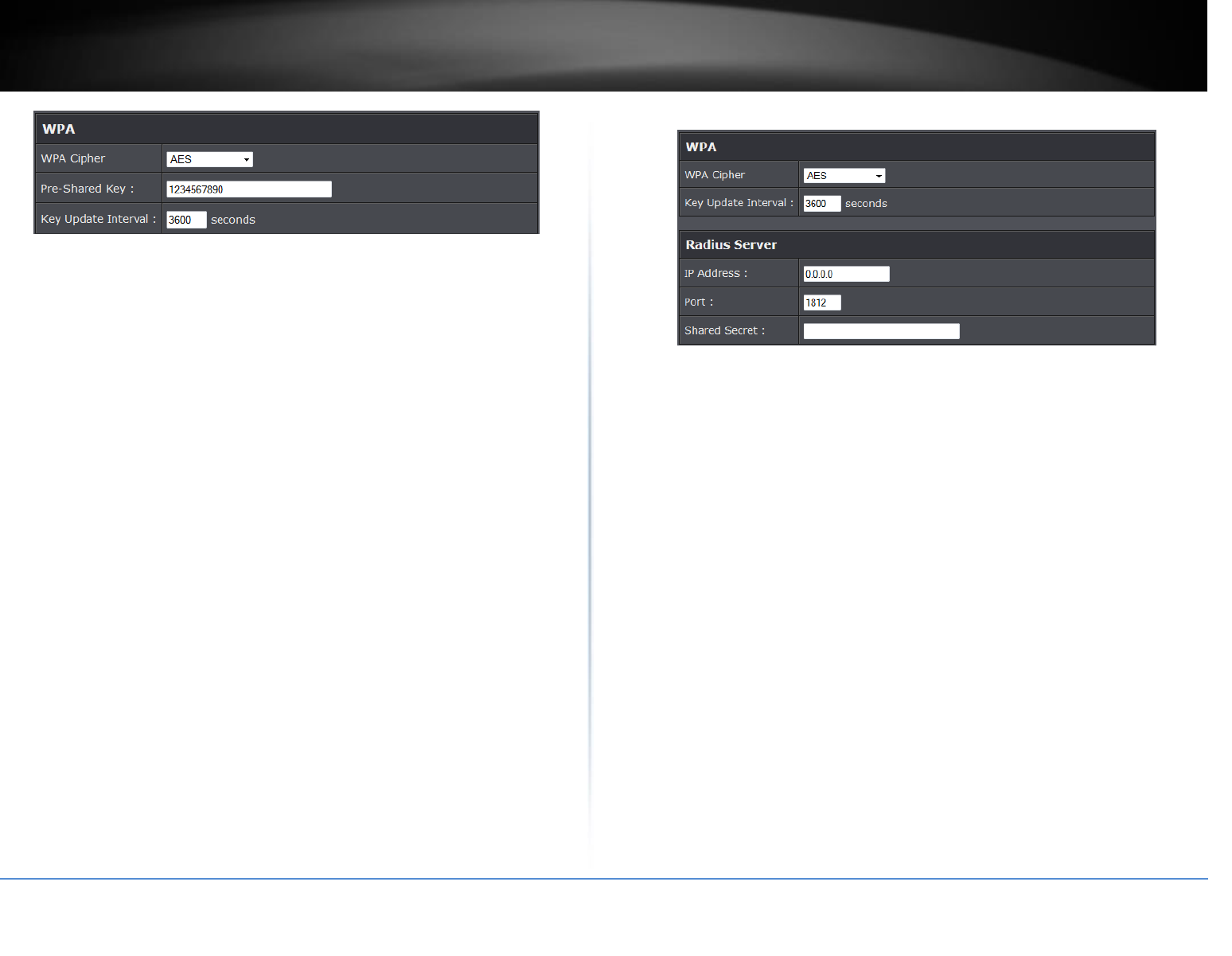
© Copyright 2015 TRENDnet. All Rights Reserved.
TRENDet User’s Guide
TEW-755AP
14
The following section outlines options when selecting WPA-Personal, WPA2- Personal,
or WPA2- Personal Mixed (Preshared Key Protocol),
WPA Cipher: Select a Cipher Type to use. When selecting WPA-PSK security, it is
recommended to use TKIP + AES.
o When selecting WPA2- Personal Mixed security, it is recommended to use
TKIP+AES.
o When selecting WPA2- Personal security, it is recommended to use AES.
Pre-Shared Key: Enter the passphrase or password
o This is the password or key that is used to connect your computer to this router
wirelessly
Note: 8-63 alphanumeric characters (a,b,C,?,*, /,1,2, etc.)
Key Update Interval: Enter the time interval (seconds) of when the network
passphrase will rotate.
Note: It is recommended to use the default interval time. Your passphrase will not
change, rotation of the key is part of the WPA protocol and designed to increase
security.
Selecting WPA-Enterprise, WPA2-Enterprise, or WPA2-Enterprise Mixed:
The following section outlines options when selecting WPA-Enterprise. WPA2-
Enterprise or WPA2-Enterprise Mixed known as EAP (Extensible Authentication
Protocol). Also known as called Remote Authentication Dial-In User Service or RADIUS.
Note: This security type requires an external RADIUS server, PSK only requires you to
create a passphrase.
WPA Cipher: Select a Cipher Type to use. When selecting WPA-PSK security, it is
recommended to use TKIP + AES.
Key Update Interval: Enter the time interval (seconds) of when the network
passphrase will rotate.
Note: It is recommended to use the default interval time. Your passphrase will not
change, rotation of the key is part of the WPA protocol and designed to increase
security.
IP Address: Enter the IP address of the RADIUS server. (e.g. 192.168.10.250)
Port: Enter the port your RADIUS server is configured to use for RADIUS
authentication.
Note: It is recommended to use port 1812 which is typical default RADIUS port.
Shared Secret: Enter the shared secret used to authorize your router with your
RADIUS server.
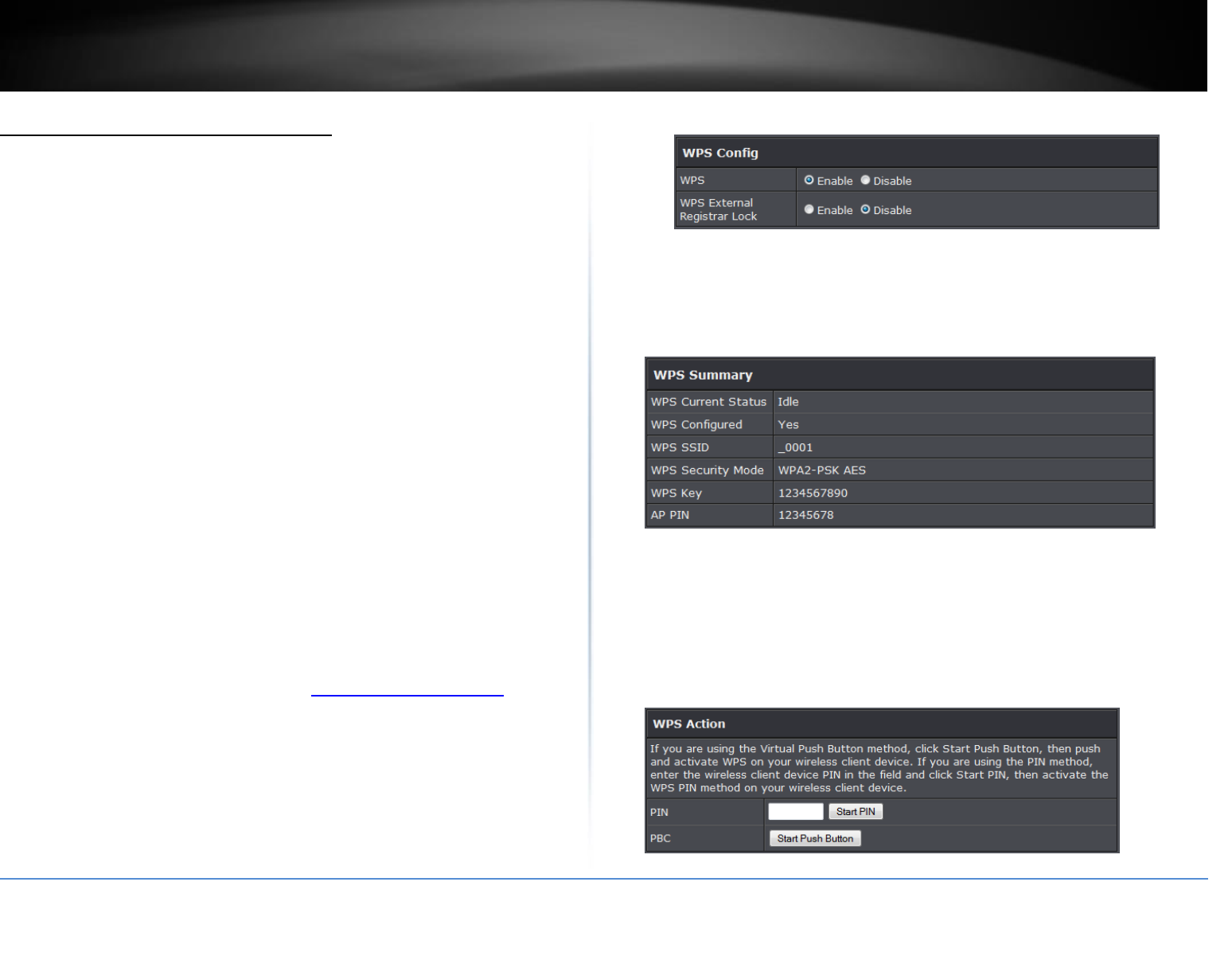
© Copyright 2015 TRENDnet. All Rights Reserved.
TRENDet User’s Guide
TEW-755AP
15
Connect wireless devices using WPS
WPS (Wi-Fi Protected Setup) is a feature that makes it easy to connect devices to your
wireless network. If your wireless devices support WPS, you can use this feature to
easily add wireless devices to your network.
Note: You will not be able to use WPS if you set the SSID Broadcast setting to Disabled or
if you are using WEP security.
There are two methods the WPS feature can easily connect your wireless devices to
your network.
Push Button Configuration (PBC) method
o WPS Software/Virtual Push Button - located in router management page
PIN (Personal Identification Number) Method - located in router management page
Note: Refer to your wireless device documentation for details on the operation of
WPS.
For connecting additional WPS supported devices, repeat this process for each
additional device.
PBC (Software/Virtual Push Button)
Wireless > WPS
In addition to the hardware push button located physically on your router, the router
management page also has push button which is a software or virtual push button you
can click to activate WPS on your router.
. Κog ito ou oute aageet page see Access the management page o page
16).
2. Click on the Wireless 2.4GHz
3. Click on WPS to configure the selected wireless band’s WP“ featue. Click Apply to
save settings
WPS Config
WPS: Select enable to turn on WPS feature
WPS External Registrar Lock: Select to enable or disable external registrar feature
on the select wireless band.
WPS Summary
WPS Current Status: Displays the status of WPS feature on the selected wireless
band
WPS Configure: Displays the configured mode of the WPS feature
WPS SSID: Displays the SSID of the WPS network
WPS Security Mode: Display the security mode of the WPS network
WPS Key: Displays the security password
AP PIN: Display the WPS PIN information.
WPS Action
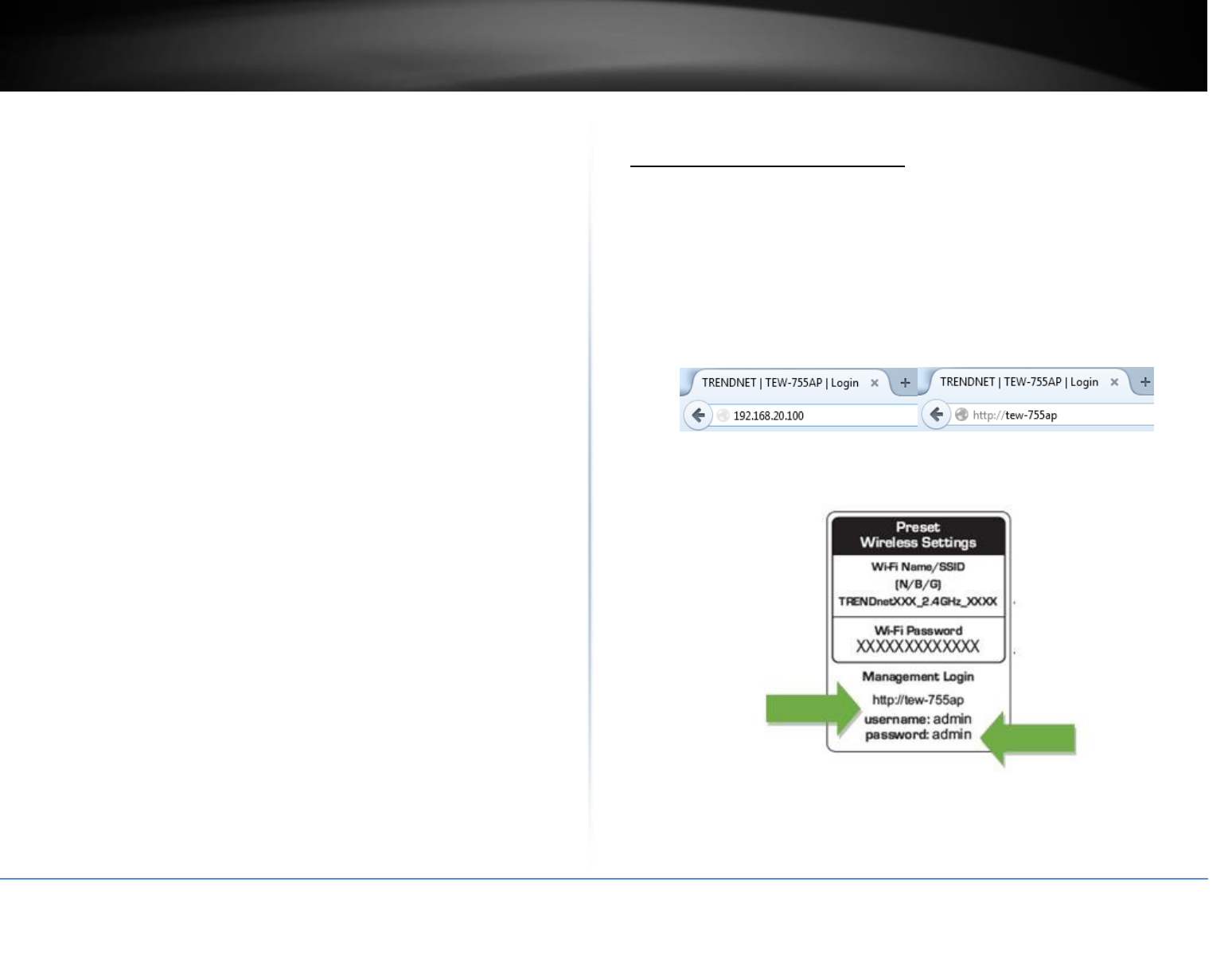
© Copyright 2015 TRENDnet. All Rights Reserved.
TRENDet User’s Guide
TEW-755AP
16
PIN: Enter the PIN information of the wireless client you want to connect to the
etok. Clik “tat PIΠ utto to atiate WP“ oe ou ete the liet’s PIΠ
information
Note: You may need to initiate the WPS PIN on your wireless device first when
using this method. Refer to your wireless device documentation for details on the
operation of WPS.
PBC: Click Start Push Button to activate WPS PBC configuration.
Advance configuration
Access the management page
Note: Your router management page URL/domain name http://TEW-755AP or IP
address http://192.168.10.100 is accessed through the use of your Internet web browser
(e.g. Internet Explorer, Firefox, Chrome, Safari, Opera) and will be referenced frequently
i this Use’s Guide.
1. Open your web browser (e.g. Internet Explorer, Firefox, Safari, Chrome, or Opera) and
go to URL/domain name http://TEW-755AP or IP address //192.168.10.100. Your
access point will prompt you for a user name and password.
2. You can find the Password on a sticker on the side of the router and on the label on
the bottom of the router.
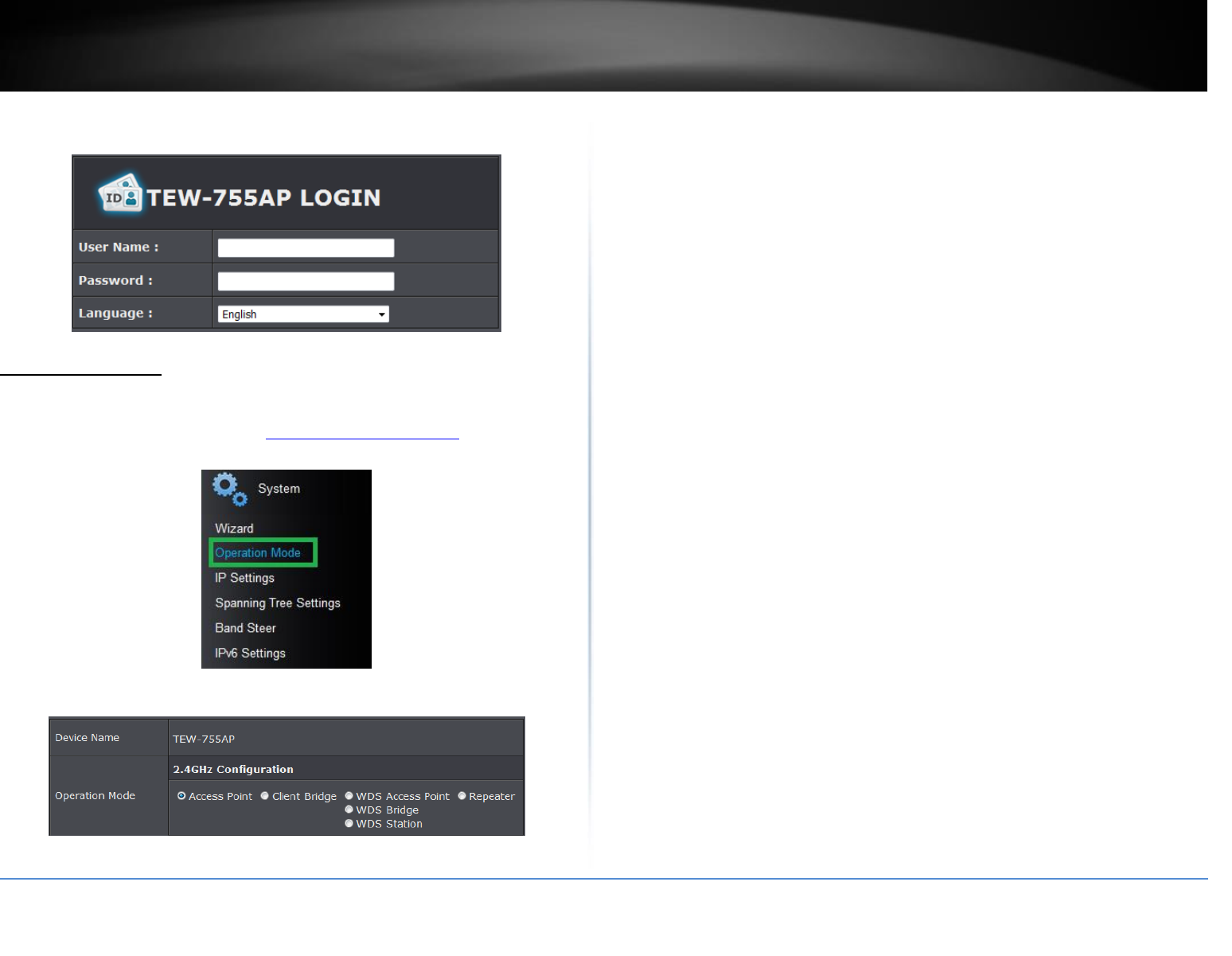
© Copyright 2015 TRENDnet. All Rights Reserved.
TRENDet User’s Guide
TEW-755AP
17
3. Enter your Username and Password, select your preferred language, and then click
Login.
Operating Modes
This section outlines the available operating modes available on the access point.
1. Log into your aageet page see Access the management page o page 16).
2. Click on System and Operation Modes.
3. Select the operating mode to apply on each wireless band.
Access Point: In this mode the device creates a wireless network to your existing
network.
Client Bridge: Select this mode to allow the access point the ability to wireless
connect to your wireless network. This is similar to a wireless laptop or mobile
device connecting to a wireless network.
WDS Access Point: In the mode the access point connects to other WDS bridge
enable devices for backbone communication and provides wireless connection to
clients (STAs) at the same time.
WDS Bridge: When this mode is selected the access point connects ONLY to other
WDS bridge enabled devices and local networks (the other wireless interface and
Ethernet interface) as a wireless backbone bridge.
WDS Station: The wireless interface connects to other WDS Bridge enabled devices
for backbone communication and connects to other wireless access points at the
same time. Use this mode to pair with the next hop access point as a WDS network
outlet.
Repeater: In this mode, the wireless interface repeats wireless signal and packets
for backbone communication as well as a client access. This feature is used to
expand your existing wireless network to areas that your current access point is
unable to reach. Make sure all of the settings of the wireless interface matches to
your root or connecting wireless access points, same SSID, channel and wireless
encryption settings.
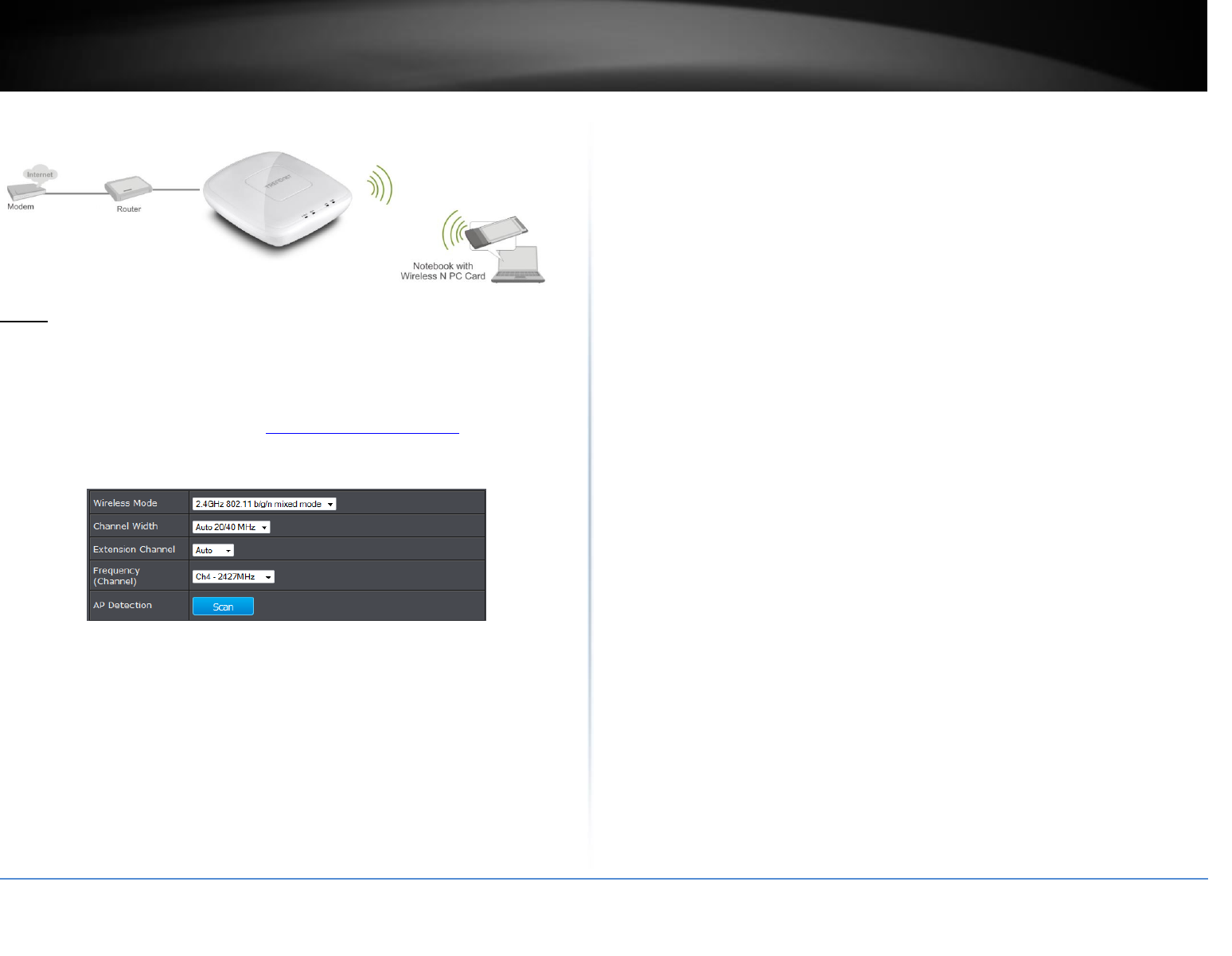
© Copyright 2015 TRENDnet. All Rights Reserved.
TRENDet User’s Guide
TEW-755AP
18
Access Point
Basic
Wireless > Wireless Network
This section outlines the available features to configure wireless 2.4GHz when Access
Point mode is selected.
1. Log into your management page (see Access the management page o page 16).
2. Click on Wireless 2.4GHz
3. Configure the below settings and click Apply to save settings.
Wireless Mode: If all of the wireless devices you want to connect with this Access
Point can connect in the same transmission mode, you can improve performance
slightly by choosing the appropriate mode. If you have some devices that use a
different transmission mode, choose the appropriate mode.
2.4GHz Wireless
o B/G/N mixed: Select this mode for the best compatibility. This mode allows older
802.11b and 802.11g wireless devices to connect to the router in addition to
newer 802.11n devices.
o B/G mixed: This mode only allows devices to connect to the router using older
and slow 80. o .g teholog ad it thee edues the oute’s
maximum speed to 54Mbps (typically not recommended).
o N only: This mode only allows newer 802.11n devices to connect to your router.
This mode does ensure the highest speed and security for your network, however
if you have older 802.11g wireless clients, they will no longer be able to connect
to this router.
o G only: This mode only allows devices to connect to the router using older and
slow 802.11g technology (typically not recommended).
o B only: This mode only allows devices to connect to the router using older and
slow 802.11b technology (typically not recommended).
Note: Please check the specifications on your wireless devices for the highest
wireless capability supported first before applying these settings. If you are
unsure, it is recommended that you keep the default setting (B/G/N mixed) for the
best compatibility.
When applying the 802.11 mode setting, please keep in mind the following:
Wireless devices that support 802.11n are backwards compatible and can
connect wirelessly at 802.11g or 802.11b.
Connecting at 802.11b or 802.11g will limit the capability of your 802.11n
supported wireless devices from obtaining higher performance and data rates.
Allowing 802.11b or 802.11g devices to connect to an 802.11n capable wireless
network may degrade the wireless network performance below the higher
performance and data rates of 802.11n.
Wireless devices that only support 802.11b or 802.11g will not be able to
connect to a wireless network that is set to 802.11n only mode.
Wireless devices that only support 802.11b will not be able to connect to a
wireless network that is set to 802.11g only mode.
Channel Width: Extension channel: When 20/40 channel bandwidth has been
chosen, you should select extension channel to get higher throughput.
Frequency (Channel): In North America, this router can broadcast on 1 of 11
Channels for 2.4GHz (13 in Europe and other countries). Selecting the Auto option
enables the router to automatically select the best Channel for wireless
communication. To manually set the channel on which the router will broadcast,
click the drop-down list and select the desired Channel for wireless communication.
The goal is to select the Channel that is least used by neighboring wireless
networks.
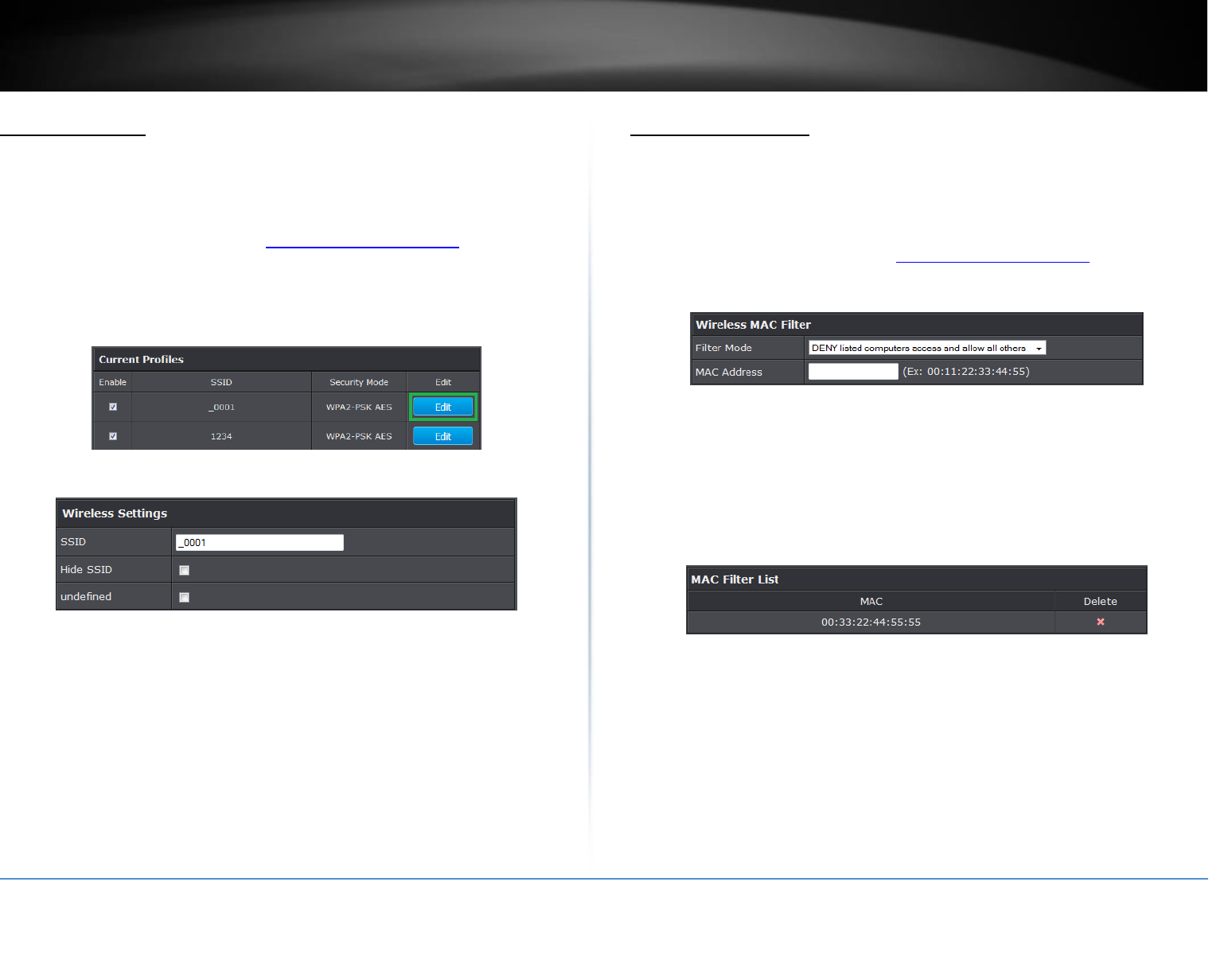
© Copyright 2015 TRENDnet. All Rights Reserved.
TRENDet User’s Guide
TEW-755AP
19
Wireless Profile
Wireless 2.4GHz > Wireless Network
This section outlines the available features to configure wireless 2.4GHz when Access
Point mode is selected.
1. Log into your aageet page see Access the management page o page 16).
2. Click on the Wireless 2.4GHz
3. Underneath the basic wireless band section, you will see Wireless Network and all
your wireless network profiles will be listed.
4. Click on the Edit button next to the wireless profile you want to configure.
5. Review the wireless settings, click Apply when finished.
SSID: Enter the wireless network name (SSID) to assign to the selected wireless
profile
Hide SSID: Select option to disable the wireless network name to broadcast
Wireless MAC filter
Wireless 2.4GHz) > Wireless MAC Filter
Every network device has a unique, 12-digit MAC (Media Access Control) address. Using
wireless MAC filters, you can allow or deny specific wireless clients using this oute’s
wireless network.
1. Log into your aageet page see Access the management page o page 16).
2. Click on the Wireless 2.4GHz.
3. Review the settings and click Apply to save settings.
Filter Mode: Select from the pull down list the MAC filter rule to apply.
o Disable: Select to turn off MAC filter feature
o DENY: Select this option to DENY all listed MAC addressed
o ALLOW: Select this option to only ALLOW the listed MAC address to the the
network.
MAC Address: Enter the MAC address to apply on the MAC filter rule
MAC Filter List
MAC: List of all MAC addresses
Delete: Click to delete selected MAC address
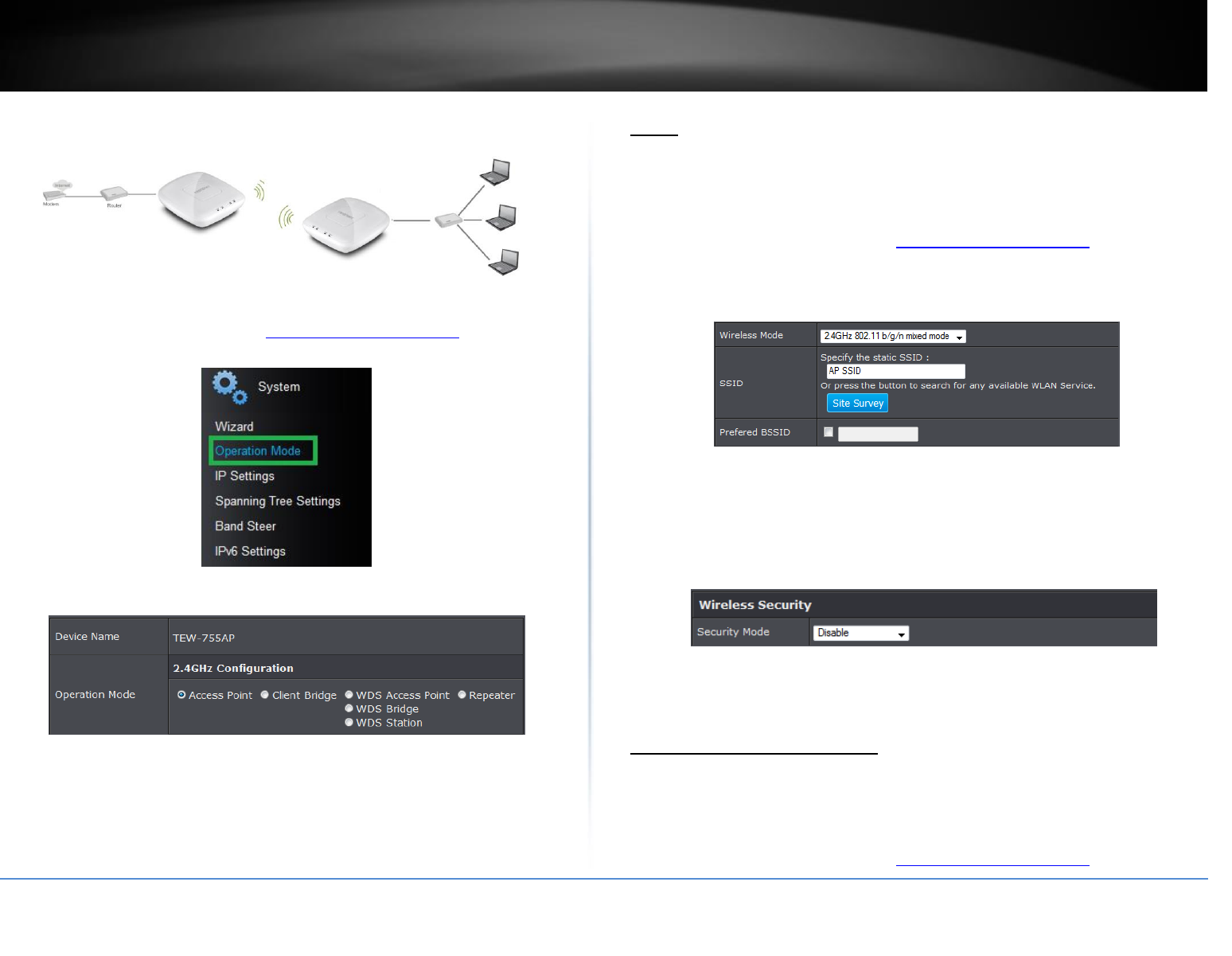
© Copyright 2015 TRENDnet. All Rights Reserved.
TRENDet User’s Guide
TEW-755AP
20
Client Bridge
1. Log into your aageet page see Access the management page o page 16).
2. Click on System and Operation Modes.
3. Select the Client Bridge and click Apply.
Basic
Wireless 2.4GHz > Wireless Network
This section outlines the available features to configure wireless 2.4GHz when Access
Point mode is selected.
1. Log into your aageet page see Access the management page o page 16).
2. Click on Wireless 2.4GHz the wireless band you would like to configure and click
Wireless Network.
3. Configure the below settings and click Apply to save settings.
Wireless Mode: Select the wireless mode to set on the selected wireless band in
client bridge mode
SSID: Manually enter the wireless network name (SSID) you want to establish
connection. Or simply click on Site Survey to scan for available wireless network.
Preferred BSSID: Click option and enter the preferred wireless network you would
like to connect to.
Security Mode: Select from the pull down menu the wireless security that is used
on the wireless network you would like to connect to.
Scan for wireless networks
Wireless 2.4GHz > Wireless Network
This section outlines the available features to configure wireless 2.4GhH when Access
Point mode is selected.
1. Log into your aageet page see Access the management page o page 16).
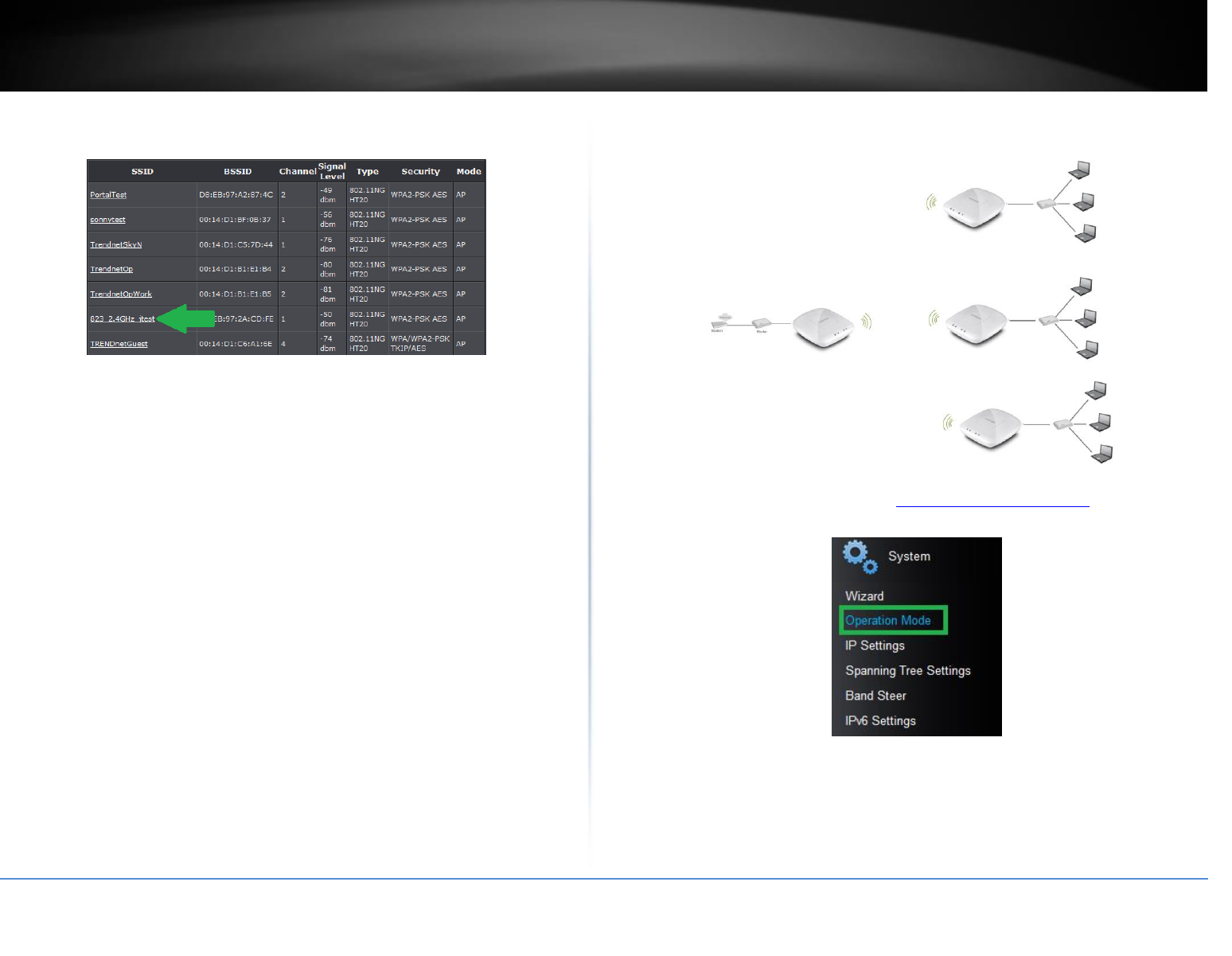
© Copyright 2015 TRENDnet. All Rights Reserved.
TRENDet User’s Guide
TEW-755AP
21
2. Click on the Wireless 2.4GHz
3. Under SSID section click Site Survey to wireless scan for available wireless networks.
4. Click on the wireless network you would like to connect. The information will
automatically fill on the previous screen. You will then need to select and enter the
wireless security.
WDS
1. Log into your management page (see Access the management page o page 16).
2. Click on System and Operation Modes.
3. Select the WDS and click Apply.
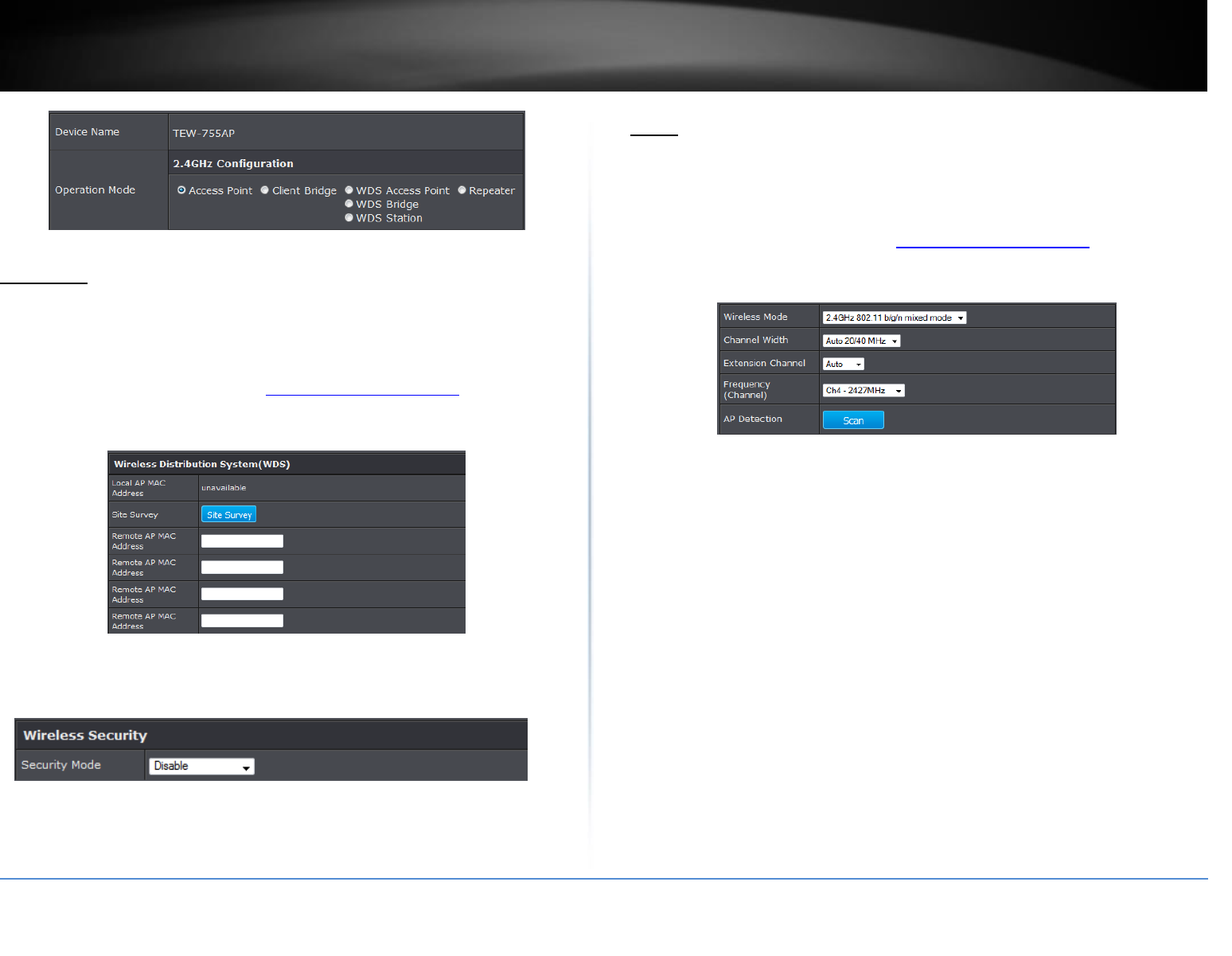
© Copyright 2015 TRENDnet. All Rights Reserved.
TRENDet User’s Guide
TEW-755AP
22
WDS Link
Wireless 2.4GHz > WDS Link Settings
This section outlines the available features to configure wireless 2.4GHz when Access
Point mode is selected.
1. Log into your aageet page see Access the management page o page 16).
2. Click on the Wireless 2.4GHz
3. Configure the below settings and click Apply to save settings.
Site Survey: Click this option to scan for available WDS networks
Remote AP MAC: Enter the MAC address of the remote access point you want to
establish WDS connection.
Security Mode: Select from the pull down menu the wireless security that is used
on the wireless network you would like to connect to.
Basic
Wireless 2.4GHz > Wireless Network
This section outlines the available features to configure wireless 2.4GHz when Access
Point mode is selected.
1. Log into your aageet page see Access the management page o page 16).
2. Click on the Wireless 2.4GHz
3. Configure the below settings and click Apply to save settings.
Wireless Mode: If all of the wireless devices you want to connect with this Access
Point can connect in the same transmission mode, you can improve performance
slightly by choosing the appropriate mode. If you have some devices that use a
different transmission mode, choose the appropriate mode.
2.4GHz Wireless
o B/G/N mixed: Select this mode for the best compatibility. This mode allows older
802.11b and 802.11g wireless devices to connect to the router in addition to
newer 802.11n devices.
o B/G mixed: This mode only allows devices to connect to the router using older
ad slo . o .g teholog ad it thee edues the oute’s
maximum speed to 54Mbps (typically not recommended).
o N only: This mode only allows newer 802.11n devices to connect to your router.
This mode does ensure the highest speed and security for your network, however
if you have older 802.11g wireless clients, they will no longer be able to connect
to this router.
o G only: This mode only allows devices to connect to the router using older and
slow 802.11g technology (typically not recommended).
o B only: This mode only allows devices to connect to the router using older and
slow 802.11b technology (typically not recommended).
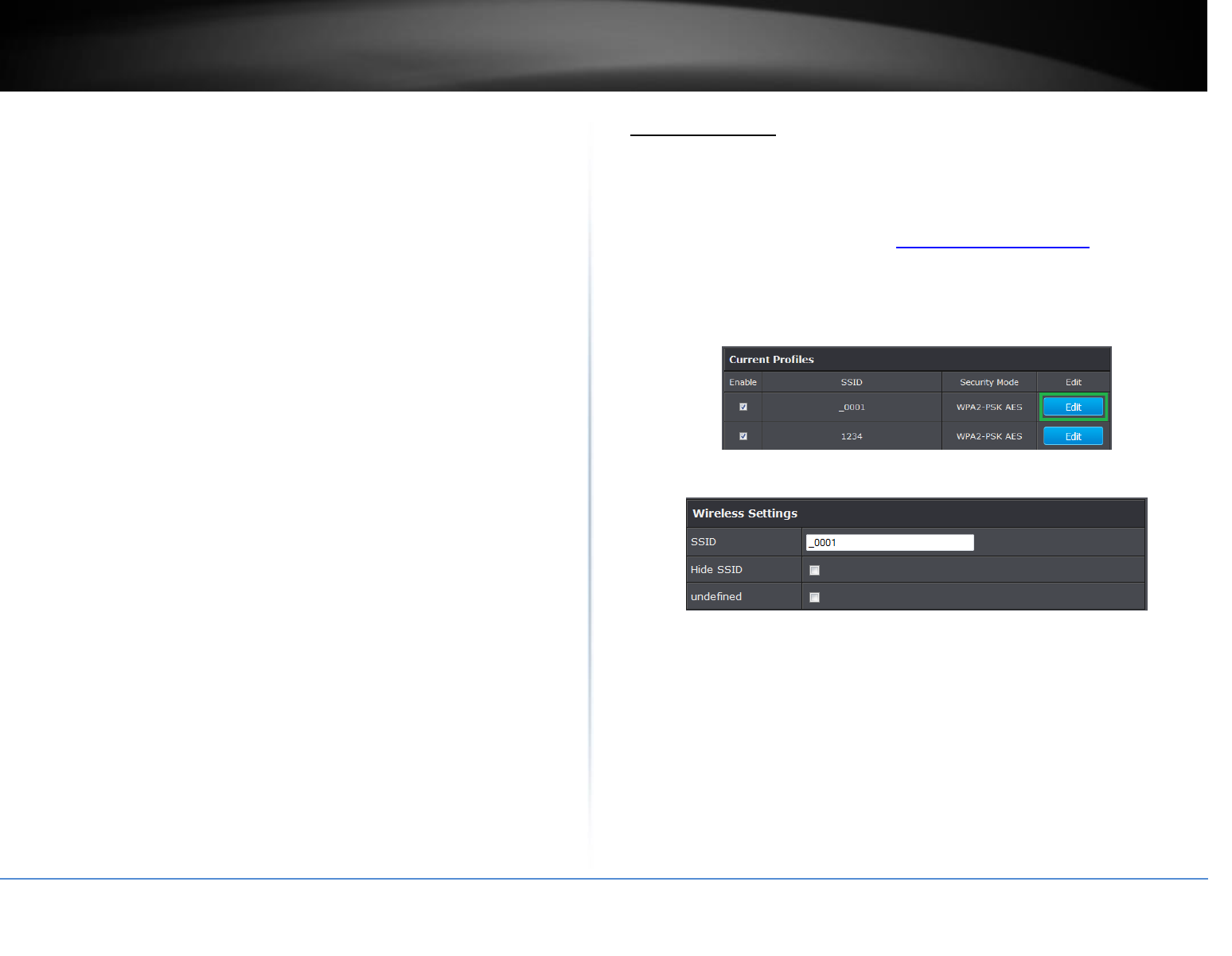
© Copyright 2015 TRENDnet. All Rights Reserved.
TRENDet User’s Guide
TEW-755AP
23
Note: Please check the specifications on your wireless devices for the highest
wireless capability supported first before applying these settings. If you are
unsure, it is recommended that you keep the default setting (B/G/N mixed) for the
best compatibility.
When applying the 802.11 mode setting, please keep in mind the following:
Wireless devices that support 802.11n are backwards compatible and can
connect wirelessly at 802.11g or 802.11b.
Connecting at 802.11b or 802.11g will limit the capability of your 802.11n
supported wireless devices from obtaining higher performance and data rates.
Allowing 802.11b or 802.11g devices to connect to an 802.11n capable wireless
network may degrade the wireless network performance below the higher
performance and data rates of 802.11n.
Wireless devices that only support 802.11b or 802.11g will not be able to
connect to a wireless network that is set to 802.11n only mode.
Wireless devices that only support 802.11b will not be able to connect to a
wireless network that is set to 802.11g only mode.
Channel Width: Extension channel: When 20/40 channel bandwidth has been
chosen, you should select extension channel to get higher throughput.
Frequency (Channel): In North America, this router can broadcast on 1 of 11
Channels for 2.4GHz (13 in Europe and other countries). Selecting the Auto option
enables the router to automatically select the best Channel for wireless
communication. To manually set the channel on which the router will broadcast,
click the drop-down list and select the desired Channel for wireless communication.
The goal is to select the Channel that is least used by neighboring wireless
networks.
Wireless Profile
Wireless 2.4GHz > Wireless Network
This section outlines the available features to configure 2.4GHz when Access Point mode
is selected.
1. Log into your aageet page see Access the management page o page 16).
2. Click on the Wireless 2.4GHz and click Wireless Network.
3. Underneath the basic wireless band section, you will see Wireless Network and all
your wireless network profiles will be listed.
4. Click on the Edit button next to the wireless profile you want to configure.
5. Review the wireless settings, click Apply when finished.
SSID: Enter the wireless network name (SSID) to assign to the selected wireless
profile
Hide SSID: Select option to disable the wireless network name to broadcast
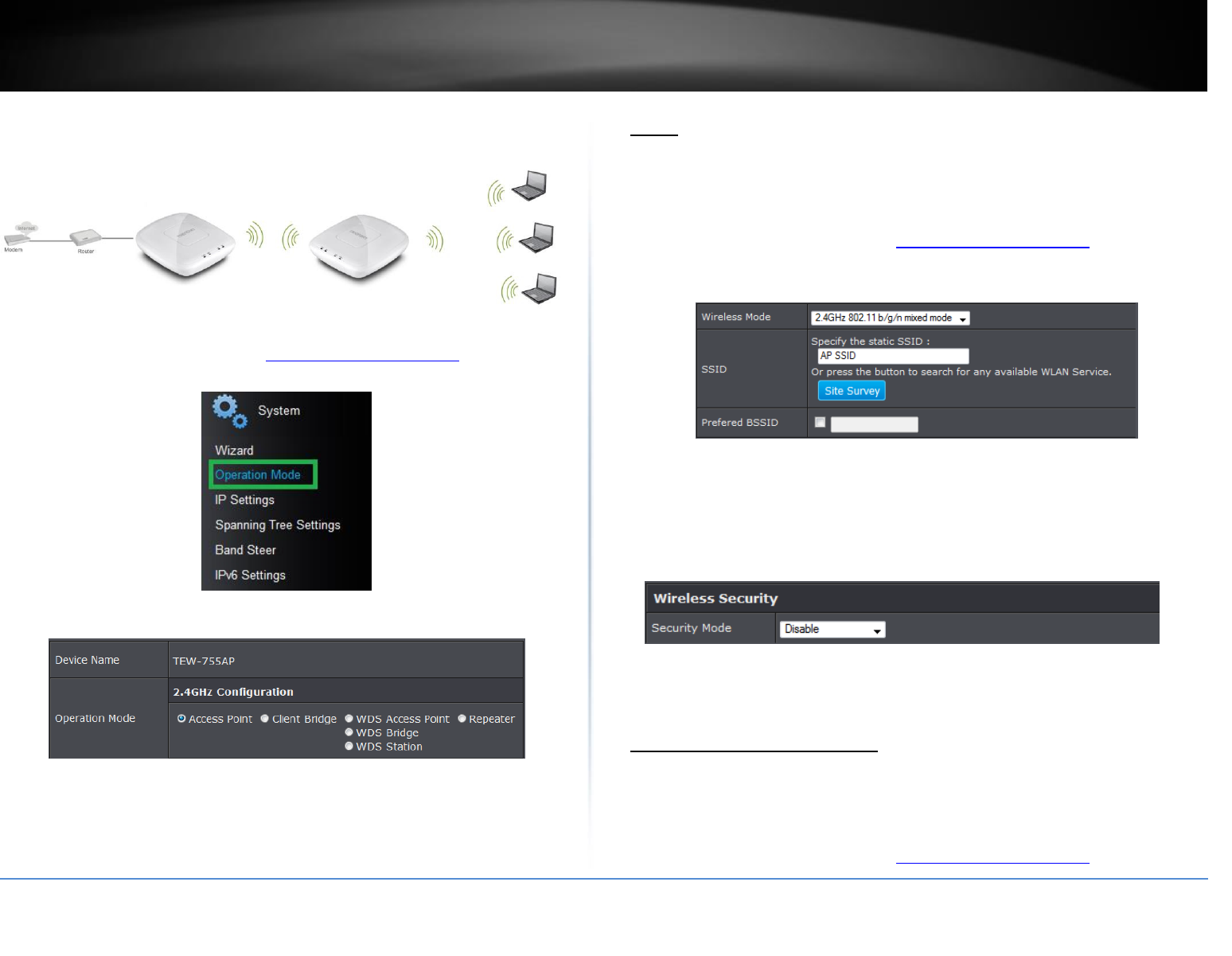
© Copyright 2015 TRENDnet. All Rights Reserved.
TRENDet User’s Guide
TEW-755AP
24
Repeater
1. Log into your aageet page see Access the management page o page 16).
2. Click on System and Operation Modes.
3. Select the Repeater and click Apply.
Basic
Wireless 2.4GHz > Wireless Network
This section outlines the available features to configure wireless 2.4GHz when Access
Point mode is selected.
1. Log into your aageet page see Access the management page o page 16).
2. Click on the Wireless 2.4GHz
3. Configure the below settings and click Apply to save settings.
Wireless Mode: Select the wireless mode to set on the selected wireless band in
client bridge mode
SSID: Manually enter the wireless network name (SSID) you want to establish
connection. Or simply click on Site Survey to scan for available wireless network.
Preferred BSSID: Click option and enter the preferred wireless network you would
like to connect to.
Security Mode: Select from the pull down menu the wireless security that is used
on the wireless network you would like to connect to.
Scan for wireless networks
Wireless 2.4GHz > Wireless Network
This section outlines the available features to configure wireless 2.4GHzwhen Access
Point mode is selected.
1. Log into your aageet page see Access the management page o page 16).
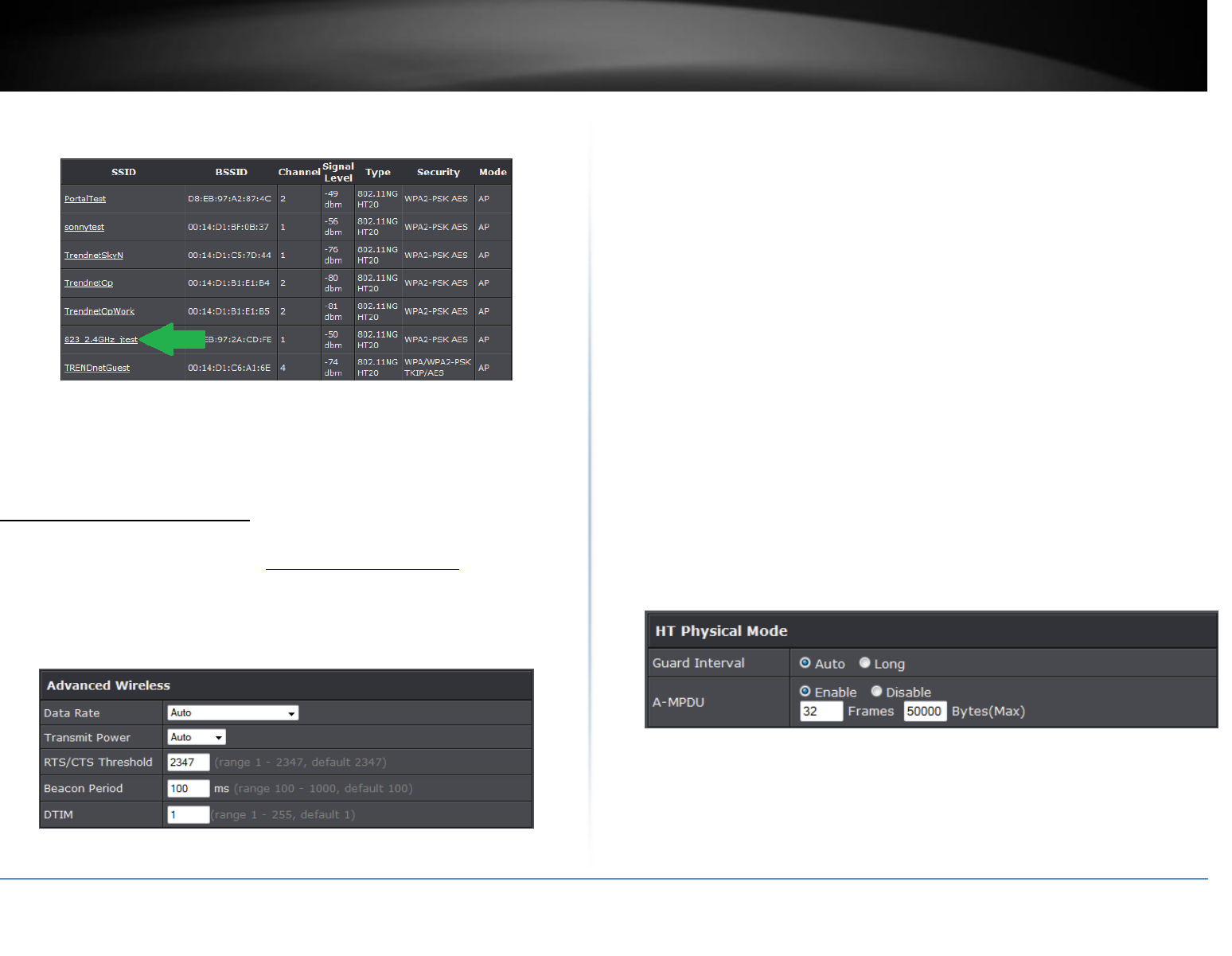
© Copyright 2015 TRENDnet. All Rights Reserved.
TRENDet User’s Guide
TEW-755AP
25
2. Click on the Wireless 2.4GHz
3. Under SSID section click Site Survey to wireless scan for available wireless networks.
4. Click on the wireless network you would like to repeat. The information will
automatically fill on the previous screen. You will then need to select and enter the
wireless security.
Advanced wireless settings
Wireless 2.4GHz > Advanced Wireless
1. Log into your aageet page see Access the management page o page 16).
2. Click on Wireless 2.4GHz and click Wireless MAC Filter.
3. Review the settings and click Apply to save settings.
Advanced Wireless
Data Rate: Select the operating wireless data rate.
Transmit Power: The wireless transmit power can be modified to a lower setting
such as 50%, 25%, and 12% if necessary. Lowering the wireless transmit may help to
better stabilize the wireless connectivity and reduce the effects of wireless
interference in areas where there are several 2.4GHz wireless devices. (Default:
100%)
RTS/CTS Threshold: The Request To Send (RTS) function is part of the networking
protocol. A wireless device that needs to send data will send a RTS before sending
the data in question. The destination wireless device will send a response called
Clear to Send (CTS). The RTS Threshold defines the smallest data packet size
allowed to initiate the RTS/CTS function.
Default Value: 2347 (range: 256-2346)
Beacon Period: A beacon is a management frame used in wireless networks that
transmitted periodically to announce the presence and provide information about
the oute’s ieless etok. The iteal is the aout tie etee eah
beacon transmission.
DTIM: DTIM is a countdown informing clients of the next window for listening to
broadcast and multicast messages. When the access point has buffered broadcast
or multicast messages for associated clients, it sends the next DTIM with a DTIM
Interval value. Wireless clients detect the beacons and awaken to receive the
broadcast and multicast messages. The default value is 1. Valid settings are
between
1 and 255.
HT Physical Mode
Guard Interval: Select to enable short guard interval (400ns).
A-MPDU: MPDU aggregation also collects Ethernet frames to be transmitted to a
single destination, but it wraps each frame in an 802.11n MAC header. Normally
this is less efficient than MSDU aggregation, but it may be more efficient in
environments to maintain performance in noisy networks and to prevent hidden
nodes from degrading the performance.
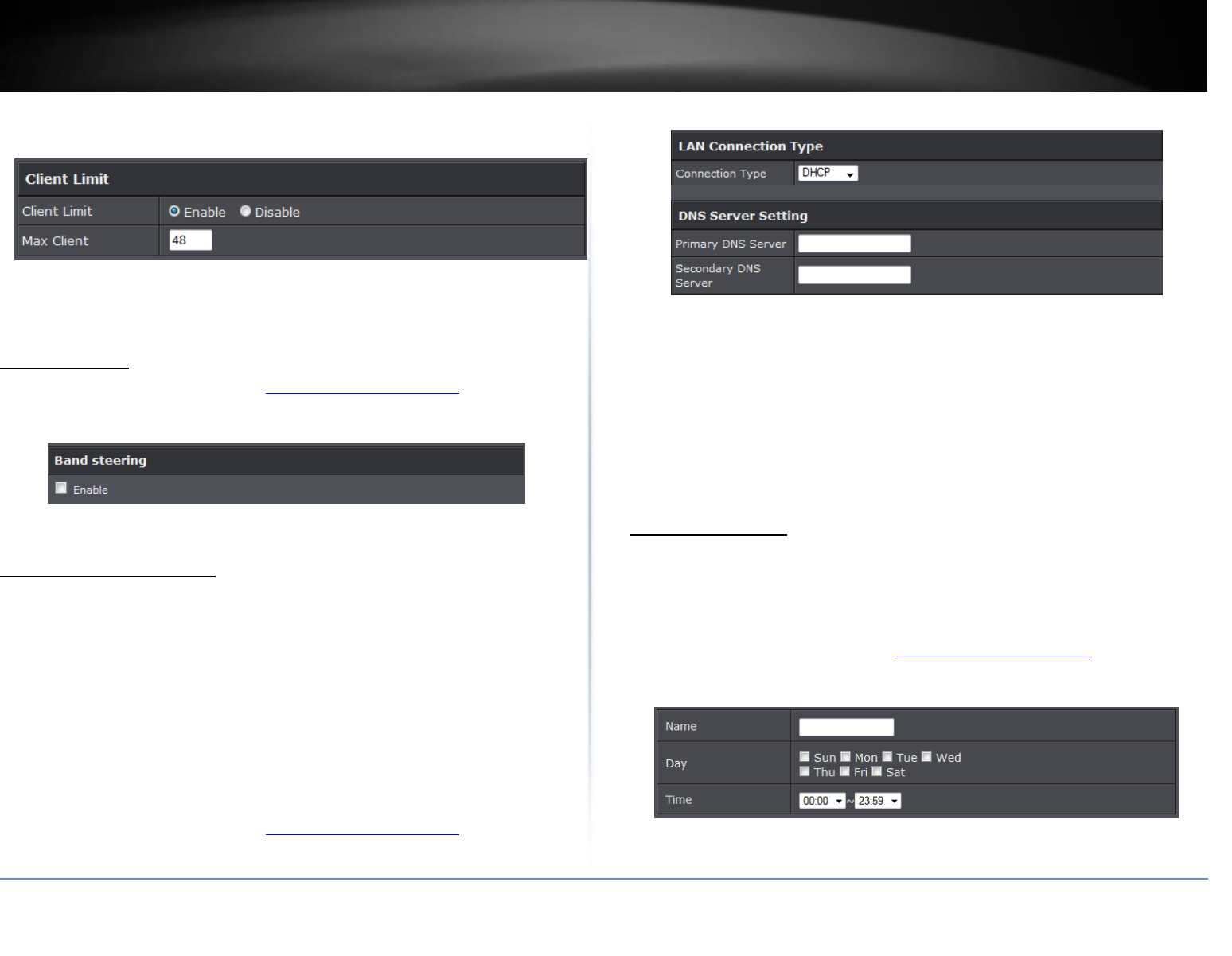
© Copyright 2015 TRENDnet. All Rights Reserved.
TRENDet User’s Guide
TEW-755AP
26
Client Limit
Client Limit: Select enable to turn on client limit of the select wireless band
Max Client: Enter the amount of clients to allow
Band Steering
1. Log into your aageet page see Access the management page o page 16).
2. Click on the System tab and click Band Steering.
3. Select enable to turn on band steering feature and click Apply to save settings.
Change your IP address
System > IP Settings
In most cases, you do not need to change the IP address settings. Typically, the IP
address settings only needs to be changed, if you plan to use another access point in
your network with the same IP address settings, if you are connecting your access point
to an existing network that is already using the IP address settings your access point is
using.
Note: If you are not encountering any issues or are not faced with one of the cases
described above or similar, it is recommended to keep your router IP address settings as
default.
Default Router IP Address: 192.168.10.100 / 255.255.255.0
1. Log into your aageet page see Access the management page o page 16).
2. Click on the System tab and click IP Settings.
3. Review the settings and click Apply to save changes.
Connection Type: Select on the pull down menu the LAN connection type.
o DHCP: Select this option to have the access point obtain an IP address from your
DHCP server
o STATIC: Select this option to manually assign and IP address to your access point
DNS Server: Ete ou etok’s DΠ“ see IP addess
Create schedules
Maintenance > Schedule
Create a schedule to define the days/time period when a feature should be active or
inactive:
1. Log into your aageet page see Access the management page o page 16).
2. Click on the Management tab and click Schedule.
3. Review the settings and click Add to save settings.
Name: Enter desired schedule name.
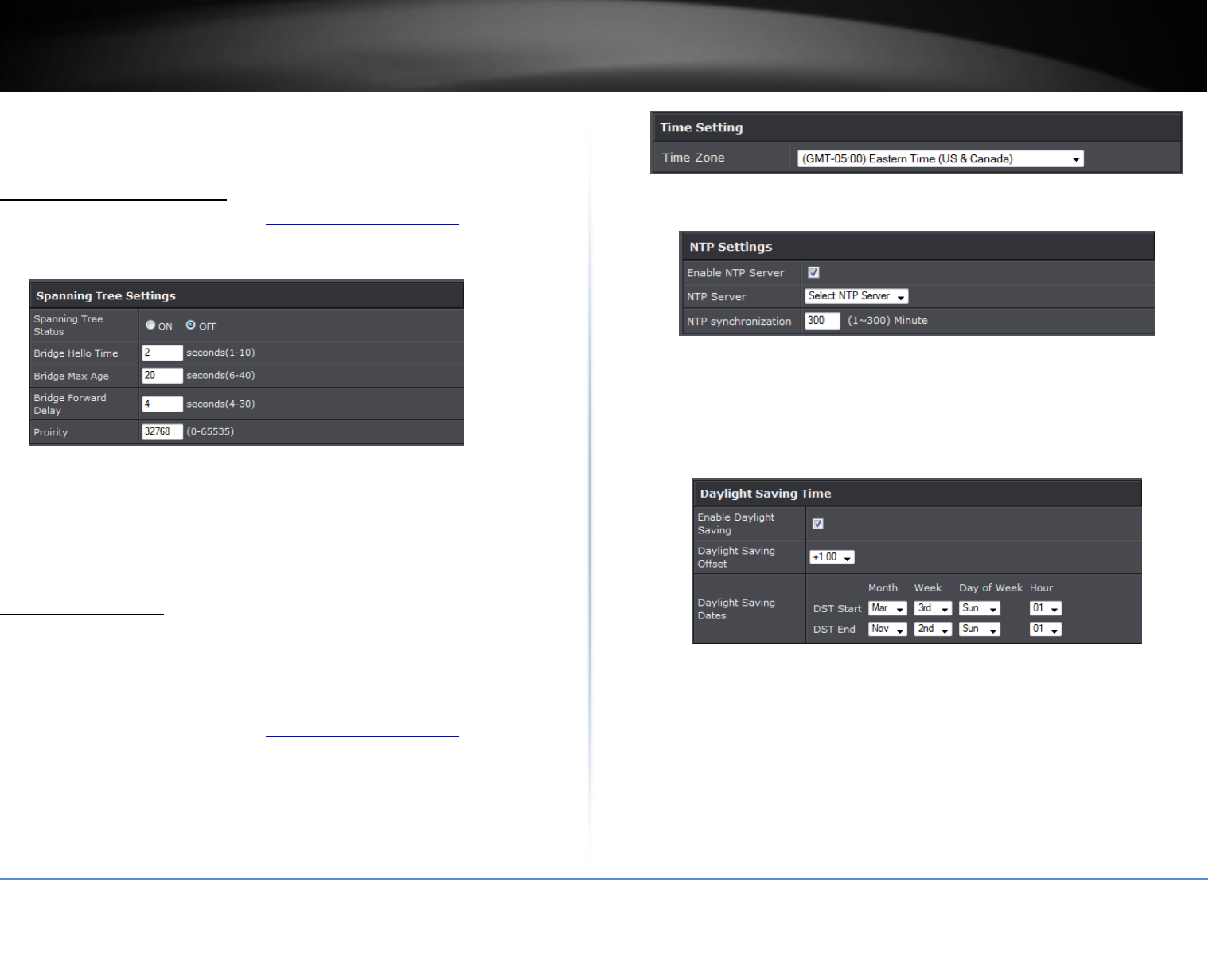
© Copyright 2015 TRENDnet. All Rights Reserved.
TRENDet User’s Guide
TEW-755AP
27
Day: Check the day(s) to implement the schedule.
Time: Specify the time period.
Configure Spanning Tree
1. Log into your aageet page see Access the management page o page 16).
2. Click on the System tab and click Spanning Tree Settings.
3. Review the settings and click Apply to save changes.
Spanning Tree Status: Select On or Off to enable or disable spanning tree feature.
Bridge Hello Time: Enter the bridge duration
Bridge Max Age: Enter the max duration
Bridge Forward Delay: Enter the delay duration
Priority: Enter the priority
Set date and time
Management > Time and Date Settings
Thee ae to ays to set the oute’s date ad tie. NTP Netok Time Protocol) is
ased o tie sees. You a also aually set the oute’s date ad tie.
Note: It is important that the time is configured correctly before setting any schedules.
1. Log into your aageet page see Access the management page o page 16).
16).
2. Click on the Management tab and click Management VLAN.
3. Next to Time Zone, click the drop-down list to select your time zone.
NTP
1. Review the settings below and click Apply to save settings.
Enable: Check option to enable NTP feature
NTP Server: Select the NTP server to use
NTP synchronization: Enter the time of when the router will continue to check for
NTP updates.
When using NTP time settings you may also configure Daylight Saving feature.
Enable: Check option to enable daylight savings
Daylight Saving Offset: Select the offset amount for daylight savings to apply
Start/End Time: Configure the start and end time of daylight savings.
Manual
1. Manually set the date and time of the access point by selecting from the pull down
menus. Click Sync Time to shoize ith ou opute’s uet tie.
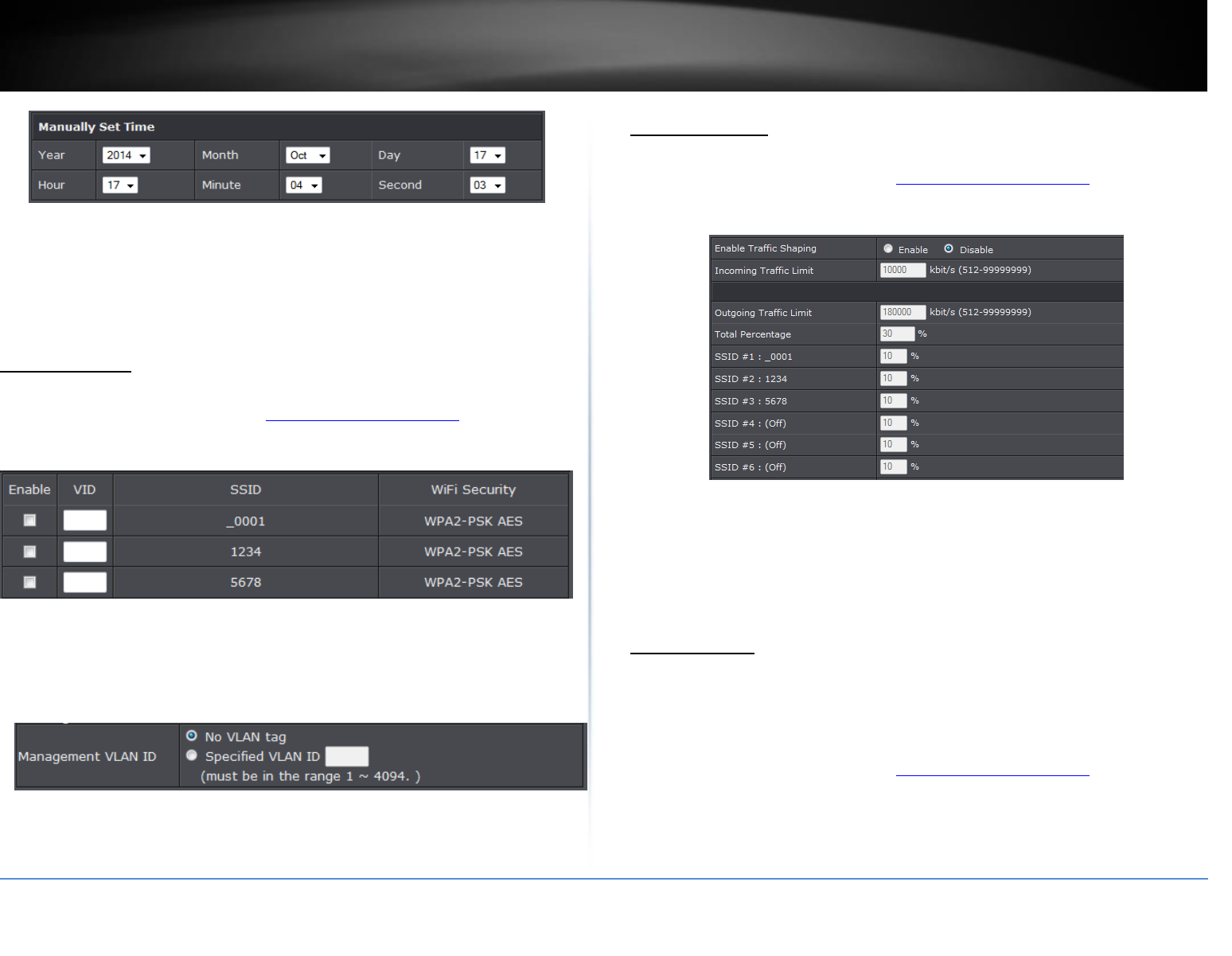
© Copyright 2015 TRENDnet. All Rights Reserved.
TRENDet User’s Guide
TEW-755AP
28
Year: Enter the year to Enable: Check option to enable NTP feature
Server IP: Enter the NTP server IP address or domain to use.
First Poll Frequency: Enter the initial time to check NTP
Thereafter Frequency: Select the time of when the router will continue to check for
NTP updates.
Manage VLAN
Management > Manage VLAN
1. Log into your aageet page see Access the management page o page 16).
2. Click on the Management tab and click Management VLAN.
3. Review the settings and click Apply to save settings.
Enable: Check box of the selected SSID to enable VLAN feature
VID: Enter the VID to assign on the selected wireless network
SSID: Displays the available SSID
WiFI Security: Displays the wireless security type of the wireless network
No VLAN Tag: Select this option to use no VLAN Tag
Specified VLAN ID: Select this option and enter the assigned VLAN ID.
Traffic Shaping
Management > Traffic Shaping
1. Log into your aageet page see Access the management page o page 16).
2. Click on the Management tab and click Traffic Shaping.
3. Review the settings and click Apply to save settings.
Enable: Check box to enable traffic shapping of the selected wireless band
Incoming Traffic: Ete ou etok’s ioud taffi liit
Outgoing Traffic Limit: Ete ou etok’s outbound traffic limit
Total percentage: Ete the seleted ieless ad’s taffi peetage to assig
SSID: Ete the ““ID’s assiged taffi peetage alloed
Enable SNMP
Management > SNMP Settings
SNMP (Simple Network Management Protocol) is a network management protocol used
to monitor (read) and/or manage (write) multiple network devices on a network. This
preconfigured external SNMP server.
1. Log into your aageet page see Access the management page o page 16).
2. Click on the Management tab and click Management VLAN.
3. Review the settings and click Apply to save settings.
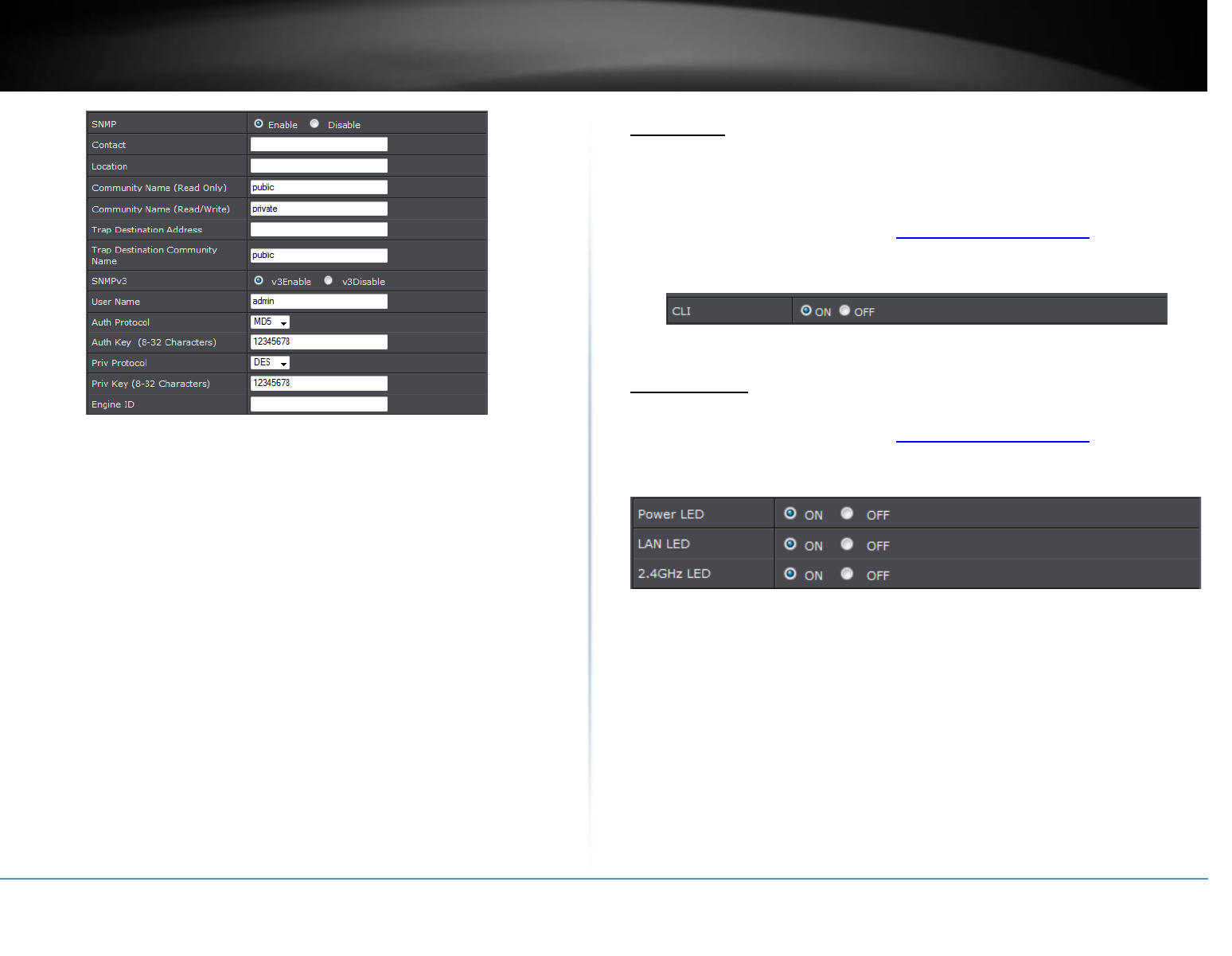
© Copyright 2015 TRENDnet. All Rights Reserved.
TRENDet User’s Guide
TEW-755AP
29
SNMP: Select enable to enable SNMP feature
Contact: Enter the contact person or contact information for your access point.
Location: Enter an assigned location for your access point.
Community Name (Read only): Enter an assigned name for your access point.
Community (Read/Write): Enter a public and private community name.
Trap Destination Address: Enter the destination IP address of the SNMP trap.
Trap Destination Community Name: Enter the name of the destination community
SNMPv3: Select option to enable or disable SNMPv3
Username: Enter the username
Auth Protocol: Select from the pull down menu the authentication protocol to use
Authentication Key: Enter the authentication key
Priv Protocol: Select the private protocol
Priv Key: Enter the private key
Engine ID: Enter the engine name
Enable CLI
Management > CLI Settings
To enable the Command Line Interface for batch management or advanced
configuration, select CLI ON and then click Apply.
1. Log into your aageet page see Access the management page o page 16).
2. Click on the Management tab and click CLI.
3. Select ON and click Apply to save settings.
LED Controls
Management > LED Control
1. Log into your aageet page see Access the management page o page 16).
2. Click on the Management tab and click LED Control.
3. Review the settings and click Apply to save settings.
Power LED: Select On to leave Power LED on or Off option to turn off.
LAN LED: Select On to leave LAN LED on or Off option to turn off.
2.4GHz LED: Select On to leave wireless 2.4GHz LED on or Off option to turn off.
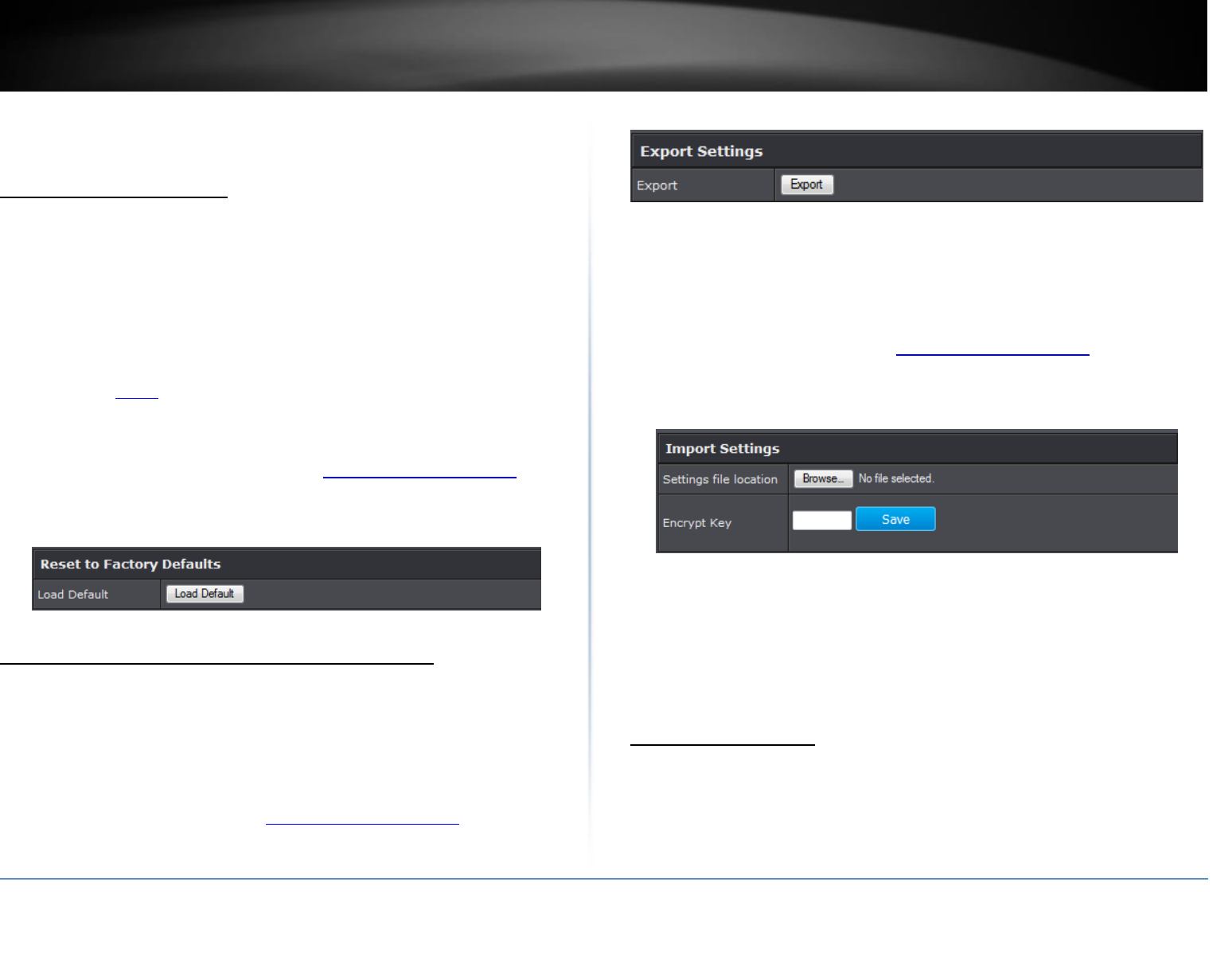
© Copyright 2015 TRENDnet. All Rights Reserved.
TRENDet User’s Guide
TEW-755AP
30
Maintenance & Monitoring
Reset to factory defaults
Management > Backup/Restore Settings
You may want to reset the access point to factory defaults if you are encountering
difficulties and have attempted all other troubleshooting. Before you reset to defaults, if
possible, you should backup your router cofiguatio fist, see Backup and restore
ou oute ofiguatio settigs o page 23.
There are two methods that can be used to reset your router to factory defaults.
Reset Button: Located on the front pael of ou oute, see Product Hardware
Features o page 2 . Use this method if you are encountering difficulties with
accessing your router management page.
OR
Router Management Page
1. Log into your aageet page see Access the management page o
page 16).
2. Click on the Management tab and click Backup/Restore Settings.
3. Click Load Default.
Backup and restore your configuration settings
Management > Backup/Restore Settings
You may have added many customized settings to your router and in the case that you
need to reset your router to default, all your customized settings would be lost and
would require you to manually reconfigure all of your router settings instead of simply
restoring from a backed up router configuration file.
To backup your configuration:
1. Log into your management page see Access the management page o page 16).
2. Click on the Management tab and click Backup/Restore Settings.
3. Click Export Settings.
4. Depending on your web browser settings, you may be prompted to save a file (specify
the location) or the file may be downloaded automatically to the web browser
settings default download folder. (Default Filename: config.bin)
5. Save the configuration file to location on your computer.
To restore your configuration:
1. Log into your aageet page see Access the management page o page 16).
2. Click on the Management tab and click Backup/Restore Settings.
3. Under Import Settings, depending on your web browser, click on Browse or Choose
File. A separate file navigation window should open.
4. Navigate to the location of the router configuration file to restore.
(Default Filename: config.bin).
5. Select the router configuration file to restore. Enter the login password under
Encrypt Key and click Save.
(Default Filename: config.bin). If prompted, click Yes or OK.
6. Wait for the router to restore settings.
Restart access point
Management > Backup/Restore Settings
You may want to restart your router if you are encountering difficulties with your router
and have attempted all other troubleshooting.
There are two methods that can be used to restart your router.
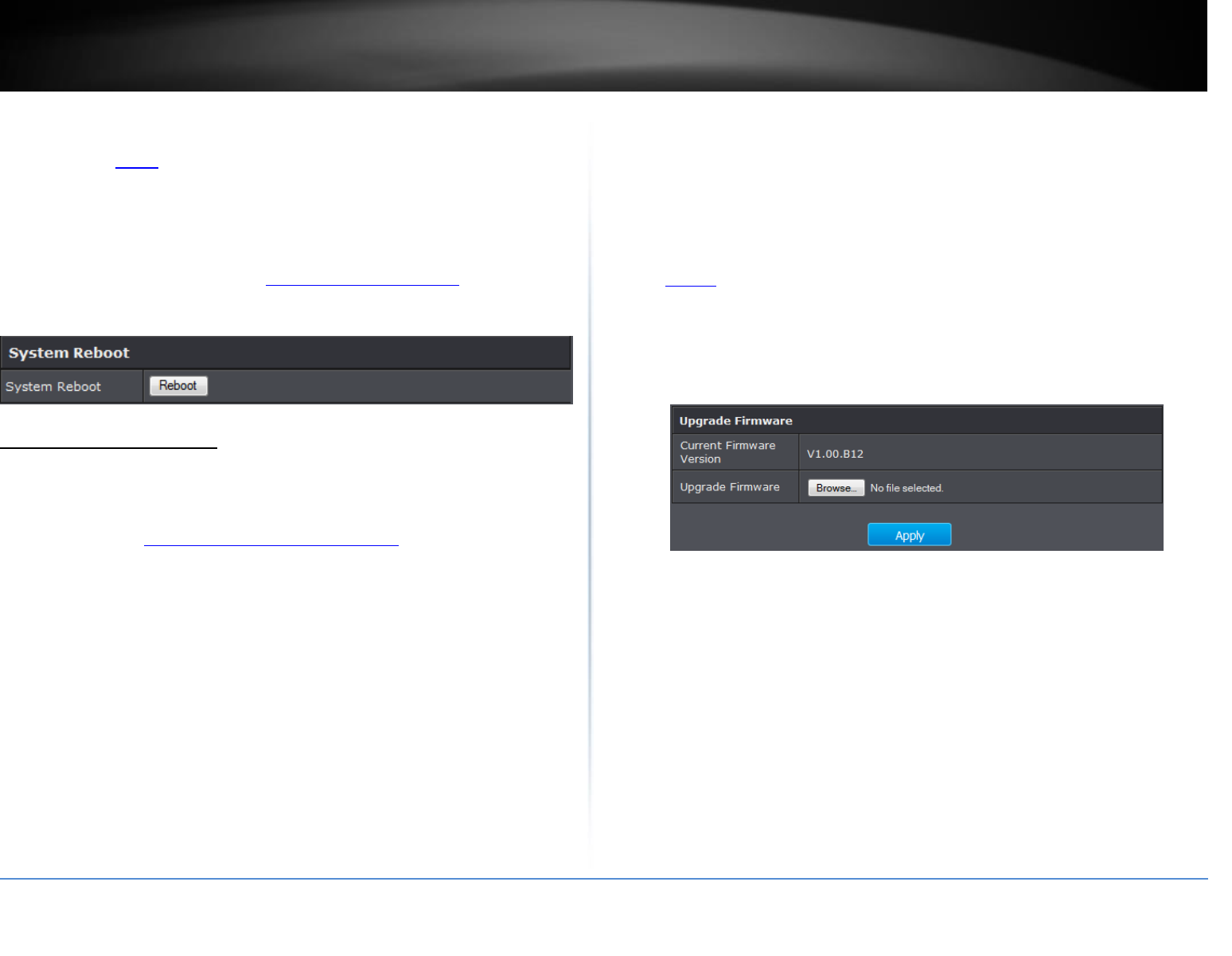
© Copyright 2015 TRENDnet. All Rights Reserved.
TRENDet User’s Guide
TEW-755AP
31
Turn the router off disconnect the power adapter from the rear panel of your
router for 10 seconds and reconnect the power adapter, see Podut Hadae
Featues o page 2 .
Use this method if you are encountering difficulties with accessing your router
management page. This is also known as a hard reboot or power cycle.
OR
Router Management Page: This is also known as a soft reboot or restart.
1. Log into your aageet page see Access the management page o page 16).
2. Click on the Management tab and click Backup/Restore Settings.
3. Click Reboot to restart the router. If prompted, click yes or OK.
Upgrade your firmware
Maintenance > FW Upgrade
TRENDnet may periodically release firmware upgrades that may add features or fix
problems associated with your TRENDnet router model and version. To check if there is
a firmware upgrade available for your device, please check your TRENDnet model and
version using the link. http://www.trendnet.com/downloads/
In addition, it is also important to verify if the latest firmware version is newer than the
one your router is currently running. To identify the firmware that is currently loaded on
your router, log in to the router, and check the version located at the top right of the
router management page. If there is a newer version available, also review the release
notes to check if there were any new features you may want or if any problems were
fixed that you may have been experiencing.
1. If a firmware upgrade is available, download the firmware to your computer.
2. Unzip the file to a folder on your computer.
Please note the following:
Do not interrupt the firmware upgrade process. Do not turn off the device or press
the Reset button during the upgrade.
If you are upgrade the firmware using a laptop computer, ensure that the laptop is
connected to a power source or ensure that the battery is fully charged.
Disable sleep mode on your computer as this may interrupt the firmware upgrade
process.
Do not upgrade the firmware using a wireless connection, only using a wired
network connection.
Any interruptions during the firmware upgrade process may permanently damage
your router.
. Κog ito ou oute aageet page see Access your router management page
on page 22).
Note: You can hek you oute’s uet fiae esio at the top right of the
page.
2. Click on Maintenance, and click on FW Upgrade.
Note: This page also displays the current firmware version of your router.
3. Depending on your web browser, next to Upgrade Firmware, click Browse or Choose
File.
4. Navigate to the folder on your computer where the unzipped firmware file (.bin) is
located and select it.
5. Click Upgrade to start the firmware upgrade process. If prompted, click yes or OK.
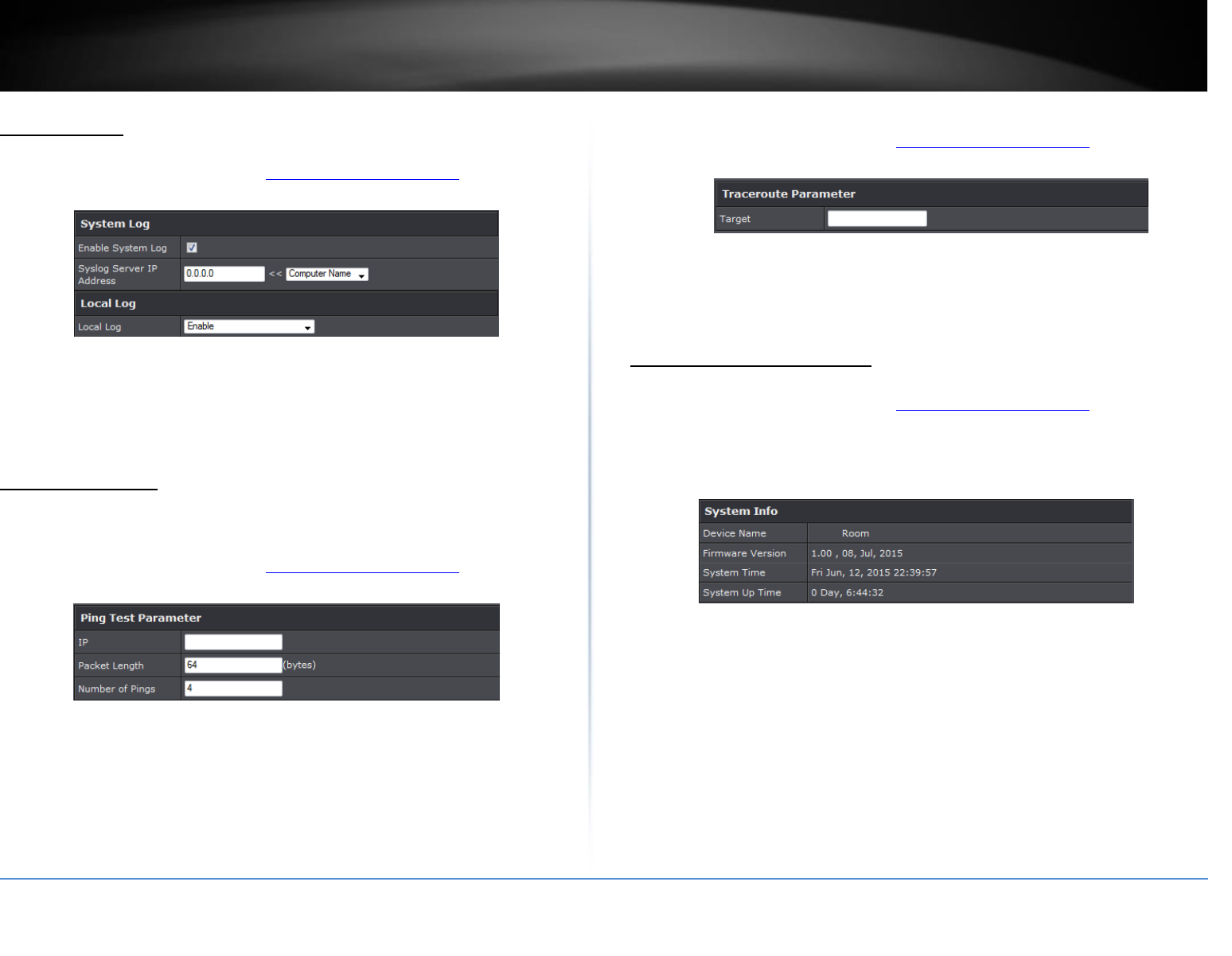
© Copyright 2015 TRENDnet. All Rights Reserved.
TRENDet User’s Guide
TEW-755AP
32
Configure log
Management > Log
1. Log into your aageet page see Access the management page o page 16).
2. Click on the Management tab and click Log. Click apply to save settings
Enable System log: Select option to enable system log feature
Syslog Server IP Address: Enter the IP address of the syslog server or select from
the pull down menu
Local Log: Select enable to enable local log feature
Test connectivity
Management > Diagnostics
Ping Test
1. Log into your aageet page see Access the management page o page 16).
2. Click on the Management tab and click Diagnostic.
IP : Enter the IP address you would like to conduct the ping test
Packet Length: Enter the packet size
Number of Pings: Enter the amount of pings to conduct.
Ping: Click to start ping test
TraceRoute
1. Log into your aageet page see Access the management page o page 16).
2. Click on the Management tab and click Diagnostic.
Target: Enter the IP address to conduct traceroute test
Traceroute: Click to start traceroute test
Check system information
Status > Main
1. Log into your management page see Access the management page o page 16).
2. Click on the Status tab and click Main.
3. Review the device information.
System
Device Name: Displays the assigned device name
Firmware Version: Displays the firmware version currently loaded on the router
System Time: Displays the current time of the device
System Up Time: Displays the time duration of how long the device has been
running
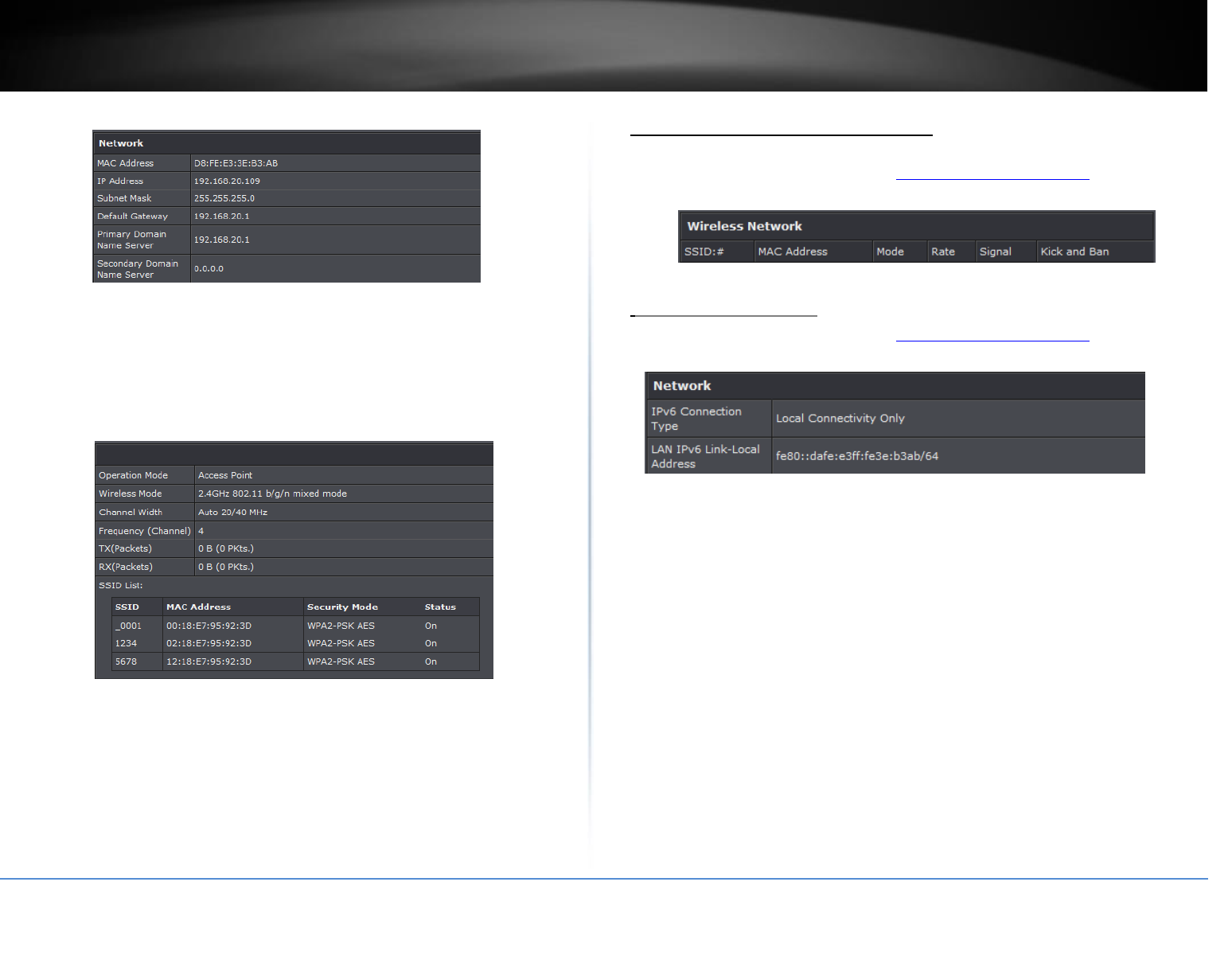
© Copyright 2015 TRENDnet. All Rights Reserved.
TRENDet User’s Guide
TEW-755AP
33
Network
MAC Address: Displas the deie’s MAC addess
IP Address: Displays the assigned IP address
Subnet Mask: Displays the subnet mask of the device
Default Gateway: Displays the default gateway of the device
Primary/Secondary DNS: Displays the DNS IP address of the device
Wireless
Operation Mode: Displays the current operating mode for each wireless band
Wireless Mode: Displays the wireless mode set on each wireless band
Channel Width: Displays the applied channel width
Frequency (Channel): Displays the current operating wireless channel
Tx/Rx Packets: Displays the Transmit (Tx) and Receive (Rx) packet rate
SSID List: Displays the multiple SSID settings.
Check connected wireless clients
Status > 2.4GHz Wireless Client
1. Log into your aageet page see Access the management page o page 16).
2. Click on the Status tab and click Wireless Client List.
Status > IPv6 Status
1. Log into your aageet page see Access the management page o page 16).
2. Click on the Status tab and click IPv6 Status.
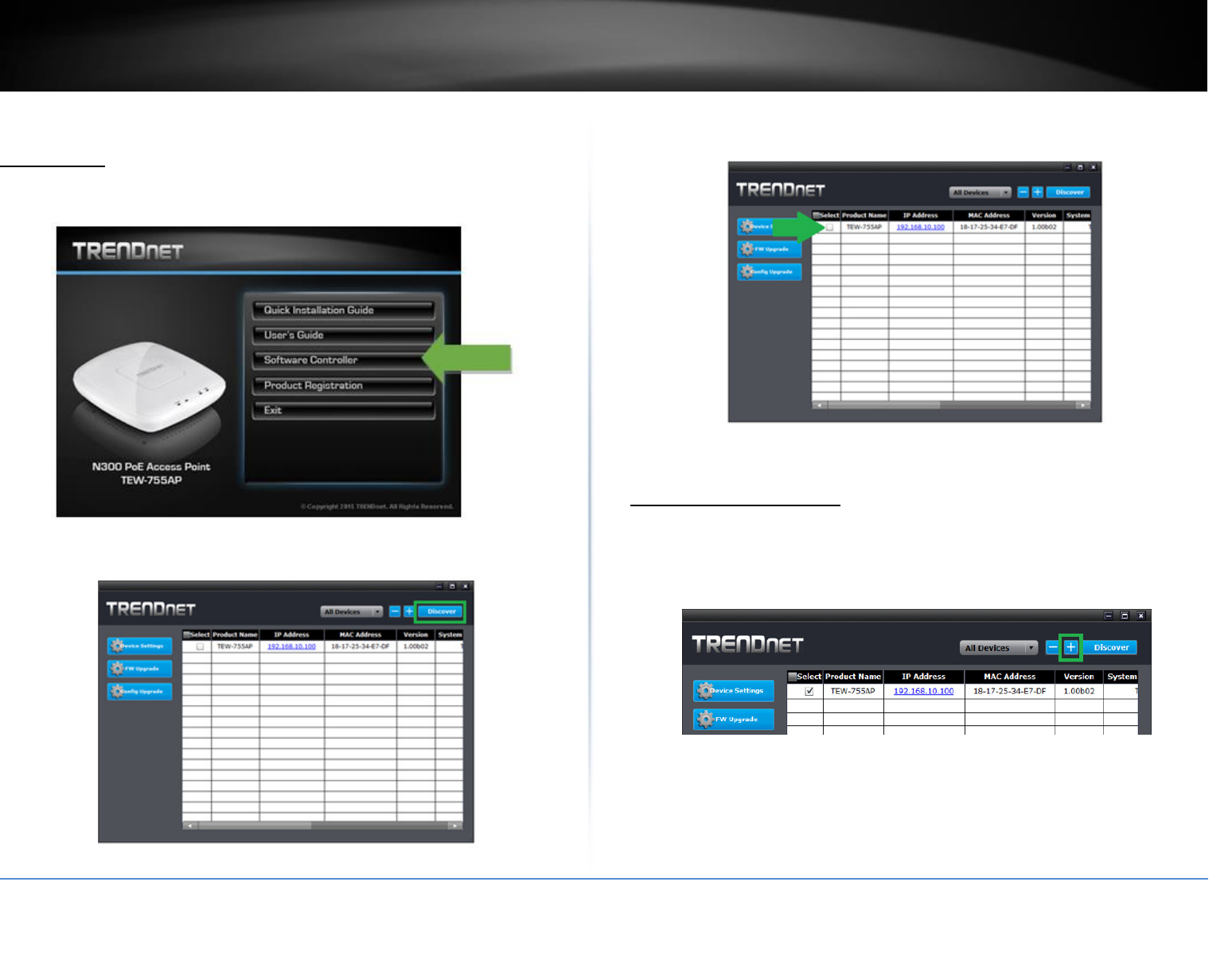
© Copyright 2015 TRENDnet. All Rights Reserved.
TRENDet User’s Guide
TEW-755AP
34
Software Controller utility
Installation
1. Insert the CD ROM included with the access point.
2. Click on Software controller to install the utility.
3. Once the utility is installed click on Discover to refresh the list of access points.
4. Select the access point you want to configure.
5. Click on Device settings to configure the access point.
Add and Delete Device
Add device
1. Run the utility
2. To add a device to otol selet the + o the uppe ight oe
3. Enter the IP address of the device you would like to add to the controller and press
OK.
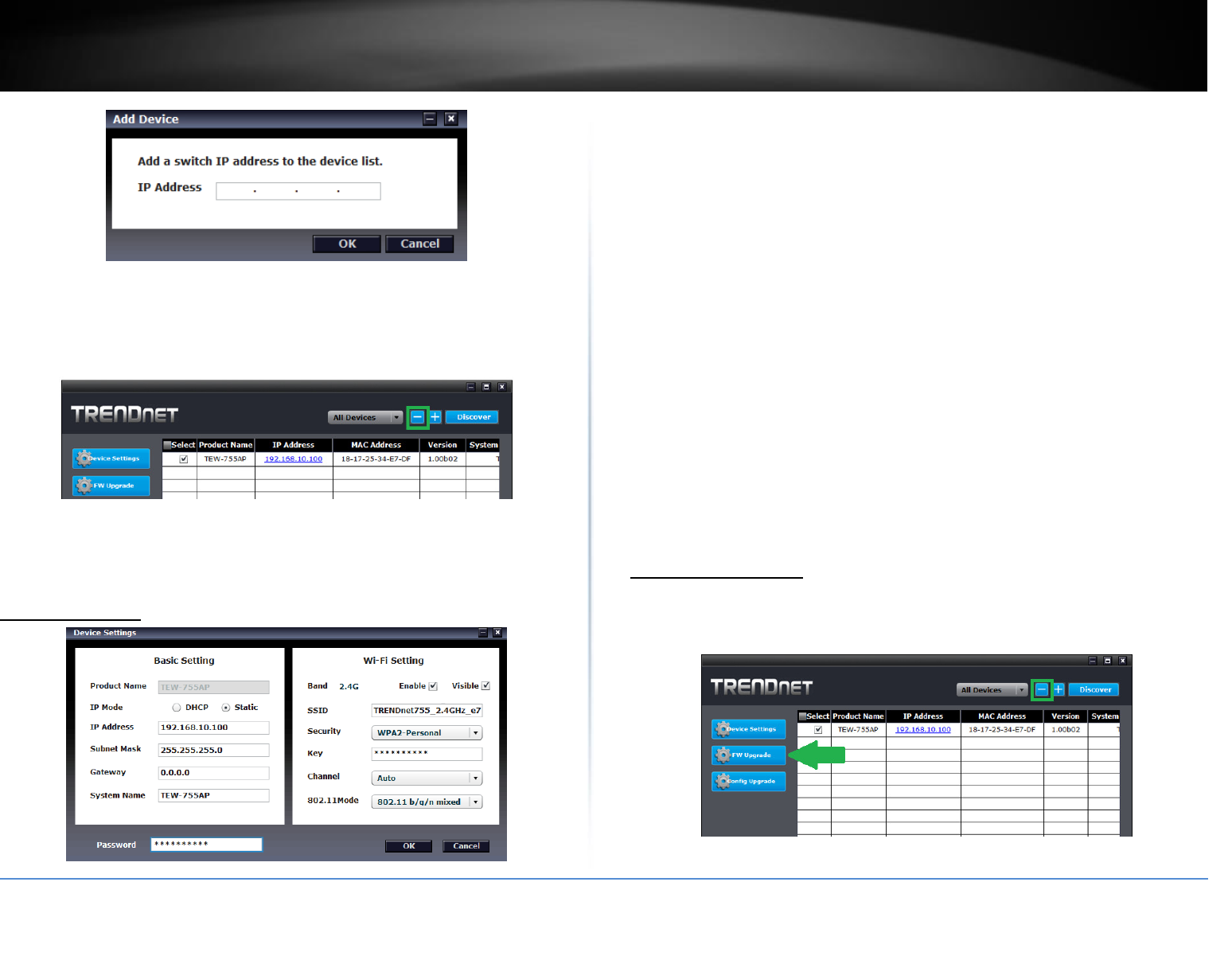
© Copyright 2015 TRENDnet. All Rights Reserved.
TRENDet User’s Guide
TEW-755AP
35
Delete device
1. Run the utility
2. To delete a device from the controller. Select the device from the listed devices and
lik -o the upper right corner
3. Enter the IP address of the device you would like to add to the controller and press
OK.
Device Settings
Product Name: Displays the device model
IP Mode: Select the IP mode to apply on the device
o DHCP: Select this option to allow the device to receive IP address from your
DHCP server
o Static: Select this option to manually set the IP address of the device
IP Address: Enter the IP address to assign to the device
Subnet Mask: Enter the subnet mask to assign to the device
Gateway: Enter the gateway IP address to assign to the device
System Name: Assign name of the device to help distinguish between similar
devices
Band: Select on the pull down menu the wireless interface to configure
Enable: Select this option to enable the selected wireless interface
Visible: Select this option to wireless broadcast the selected wireless interface
SSID: Enter the SSID (Wireless Network Name) of the selected wireless interface
Security: Select the wireless encryption security for to assign the selected
wireless interface
Key: Enter the wireless encryption security key or password
Channel: Select the wireless channel of the selected wireless interface
802.11 Mode: Select the 802.11 mode of the selected wireless interface
Password: Enter the login password of the device and click OK to save settings
Upgrade Firmware
1. Run the utility
2. Select the devices you want to conduct a firmware upgrade and click on FW upgrade
button
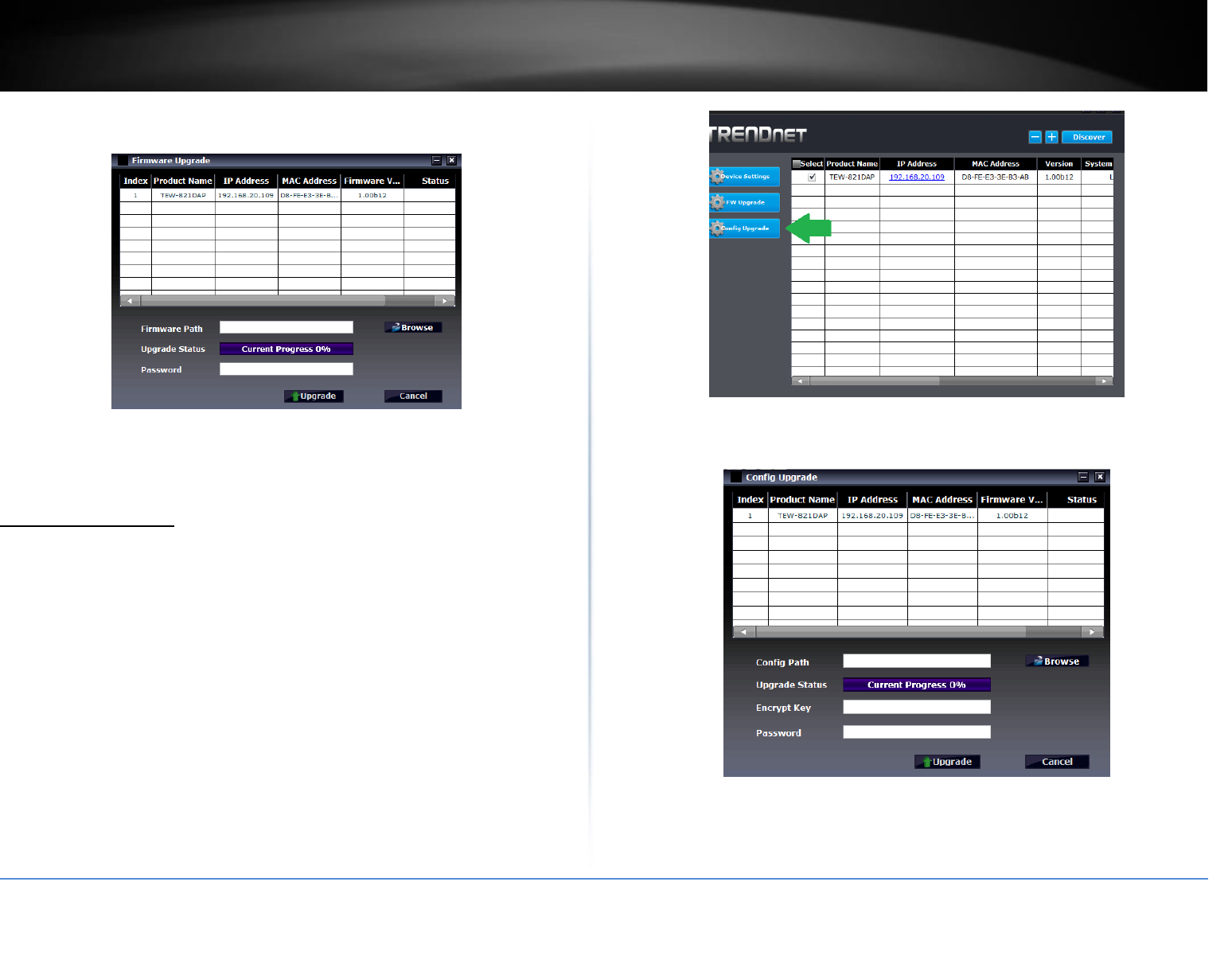
© Copyright 2015 TRENDnet. All Rights Reserved.
TRENDet User’s Guide
TEW-755AP
36
2. Click Browse button and navigate to the folder on your computer where the unzipped
firmware file (.bin) is located and select it to select the firmware
3. Enter the login password of the devices and click Upgrade to start the firmware
upgrade process.
Load configuration
1. Run the utility
2. Select the devices you want to conduct a firmware upgrade and click on FW upgrade
button
2. Click Browse button and navigate to the folder on your computer where the unzipped
firmware file (.bin) is located and select it to select the firmware
3. Enter the login password of the devices and click Upgrade to start the firmware
upgrade process.

© Copyright 2015 TRENDnet. All Rights Reserved.
TRENDet User’s Guide
TEW-755AP
37
Troubleshooting
Q: I typed http://192.168.10.1 in my Internet Browser Address Bar, but an error
essage says The page aot e displayed. How a I access the router
management page?
Answer:
. Chek ou hadae settigs agai. “ee Router Installation o page 8.
2. Make sure the LAN and WLAN lights are lit.
3. Make sure your network adapter TCP/IP settings are set to Obtain an IP address
automatically or DHCP (see the steps below).
. Make sue ou opute is oeted to oe of the oute’s ΚAΠ pots
5. Press on the factory reset button for 15 seconds, the release.
Windows 7
a. Go into the Control Panel, click Network and Sharing Center.
b. Click Change Adapter Settings, right-click the Local Area Connection icon.
c. Then click Properties and click Internet Protocol Version 4 (TCP/IPv4).
d. Then click Obtain an IP address automatically and click OK.
Windows Vista
a. Go into the Control Panel, click Network and Internet.
b. Click Manage Network Connections, right-click the Local Area Connection
icon and click Properties.
c. Click Internet Protocol Version (TCP/IPv4) and then click Properties.
d. Then click Obtain an IP address automatically and click OK.
Windows XP/2000
a. Go into the Control Panel, double-click the Network Connections icon
b. Right-click the Local Area Connection icon and the click Properties.
c. Click Internet Protocol (TCP/IP) and click Properties.
d. Then click Obtain an IP address automatically and click OK.
Note: If you are experiencing difficulties, please contact your computer or operating
system manufacturer for assistance.
Q: I am not sure what type of Internet Account Type I have for my Cable/DSL
connection. How do I find out?
Answer:
Contact your Internet Service Provider (ISP) for the correct information.
Q: The Wizard does not appear when I access the router. What should I do?
Answer:
1. Click on Wizard on the left hand side.
. Πea the top of the ose, Pop-up loked essage a appea. Right lik o
the message and select Always Allow Pop-ups from This Site.
3. Disable your browser's pop up blocker.
Q: I went through the Wizard, but I cannot get onto the Internet. What should I do?
Answer:
1. Verify that you can get onto the Internet with a direct connection into your modem
(meaning plug your computer directly to the modem and verify that your single
computer (without the help of the router) can access the Internet).
2. Power cycle your modem and router. Unplug the power to the modem and router.
Wait 30 seconds, and then reconnect the power to the modem. Wait for the modem to
fully boot up, and then reconnect the power to the router.
3. Contact your ISP and verify all the information that you have in regards to your
Internet connection settings is correct.
Q: I cannot connect wirelessly to the router. What should I do?
Answer:
1. Double check that the WLAN light on the router is lit.
2. Power cycle the router. Unplug the power to the router. Wait 15 seconds, then plug
the power back in to the router.
3. Contact the manufacturer of your wireless network adapter and make sure the
wireless network adapter is configured with the proper SSID. The preset SSID is
TRENDnet(model_number).
4. To verify whether or not wireless is enabled, login to the router management page,
click on Wireless.
. Please see Steps to improve wireless connectivity o page 21 if you continue to
have wireless connectivity problems.

© Copyright 2015 TRENDnet. All Rights Reserved.
TRENDet User’s Guide
TEW-755AP
38
Appendix
How to find your IP address?
Note: Please note that although the following procedures provided to follow for your
operating system on configuring your network settings can be used as general
guidelines, however, it is strongly recommended that you consult your computer or
operating system manufacturer directly for assistance on the proper procedure for
configuring network settings.
Command Prompt Method
Windows 2000/XP/Vista/7
1. On your keyboard, press Windows Logo+R keys simultaneously to bring up the Run
dialog box.
2. In the dialog box, type cmd to bring up the command prompt.
3. In the command prompt, type ipconfig /all to display your IP address settings.
MAC OS X
1. Navigate to your Applications folder and open Utilities.
2. Double-click on Terminal to launch the command prompt.
3. In the command prompt, type ipconfig getifaddr <en0 or en1> to display the wired
or wireless IP address settings.
Note: en0 is typically the wired Ethernet and en1 is typically the wireless Airport
interface.
Graphical Method
MAC OS 10.6/10.5
1. From the Apple menu, select System Preferences.
2. In System Preferences, from the View menu, select Network.
3. In the Network preference window, click a network port (e.g., Ethernet, AirPort,
modem). If you are connected, you'll see your IP address settings under "Status:"
MAC OS 10.4
1. From the Apple menu, select Location, and then Network Preferences.
2. In the Network Preference window, next to "Show:", select Network Status. You'll see
your network status and your IP address settings displayed.
Note: If you are experiencing difficulties, please contact your computer or operating
system manufacturer for assistance.
How to configure your network settings to obtain an IP address automatically or use
DHCP?
Note: Please note that although the following procedures provided to follow for your
operating system on configuring your network settings can be used as general
guidelines, however, it is strongly recommended that you consult your computer or
operating system manufacturer directly for assistance on the proper procedure for
configuring network settings.
Windows 7
a. Go into the Control Panel, click Network and Sharing Center.
b. Click Change Adapter Settings, right-click the Local Area Connection icon.
c. Then click Properties and click Internet Protocol Version 4 (TCP/IPv4).
d. Then click Obtain an IP address automatically and click OK.
Windows Vista
a. Go into the Control Panel, click Network and Internet.
b. Click Manage Network Connections, right-click the Local Area Connection
icon and click Properties.
c. Click Internet Protocol Version (TCP/IPv4) and then click Properties.
d. Then click Obtain an IP address automatically and click OK.
Windows XP/2000
a. Go into the Control Panel, double-click the Network Connections icon
b. Right-click the Local Area Connection icon and the click Properties.
c. Click Internet Protocol (TCP/IP) and click Properties.
d. Then click Obtain an IP address automatically and click OK.
MAC OS 10.4/10.5/10.6
a. From the Apple, drop-down list, select System Preferences.
b. Click the Network icon.
c. From the Location drop-down list, select Automatic.
d. Select and view your Ethernet connection.
In MAC OS 10.4, from the Show drop-down list, select Built-in Ethernet and
select the TCP/IP tab.
In MAC OS 10.5/10.6, in the left column, select Ethernet.
e. Configure TCP/IP to use DHCP.

© Copyright 2015 TRENDnet. All Rights Reserved.
TRENDet User’s Guide
TEW-755AP
39
In MAC 10.4, from the Configure IPv4, drop-down list, select Using DHCP and
click the Apply Now button.
In MAC 10.5, from the Configure drop-down list, select Using DHCP and click
the Apply button.
In MAC 10.6, from the Configure drop-down list, select Using DHCP and click
the Apply button.
f. Restart your computer.
Note: If you are experiencing difficulties, please contact your computer or operating
system manufacturer for assistance.
How to find your MAC address?
In Windows 2000/XP/Vista/7,
Your computer MAC addresses are also displayed in this window, however, you can type
getmac –v to display the MAC addresses only.
In MAC OS 10.4,
1. Apple Menu > System Preferences > Network
2. From the Show menu, select Built-in Ethernet.
3. On the Ethernet tab, the Ethernet ID is your MAC Address.
In MAC OS 10.5/10.6,
1. Apple Menu > System Preferences > Network
2. Select Ethernet from the list on the left.
3. Click the Advanced button.
3. On the Ethernet tab, the Ethernet ID is your MAC Address.
How to connect to a wireless network using the built-in Windows utility?
Note: Please note that although the following procedures provided to follow for your
operating system on configuring your network settings can be used as general
guidelines, however, it is strongly recommended that you consult your computer or
operating system manufacturer directly for assistance on the proper procedure for
connecting to a wireless network using the built-in utility.
Windows 7
1. Open Connect to a Network by clicking the network icon ( or ) in the notification
area.
2. In the list of available wireless networks, click the wireless network you would like to
connect to, then click Connect.
4. You may be prompted to enter a security key in order to connect to the network.
5. Enter in the security key corresponding to the wireless network, and click OK.
Windows Vista
1. Open Connect to a Network by clicking the Start Button. and then click Connect
To.
2. In the Show list, click Wireless.
3. In the list of available wireless networks, click the wireless network you would like to
connect to, then click Connect.
4. You may be prompted to enter a security key in order to connect to the network.
5. Enter in the security key corresponding to the wireless network, and click OK.
Windows XP
1. Right-click the network icon in the notification area, then click View Available
Wireless Networks.
2. In Connect to a Network, under Available Networks, click the wireless network you
would like to connect to.
3. You may be prompted to enter a security key in order to connect to the network.
4. Enter in the security key corresponding to the wireless network, and click Connect.
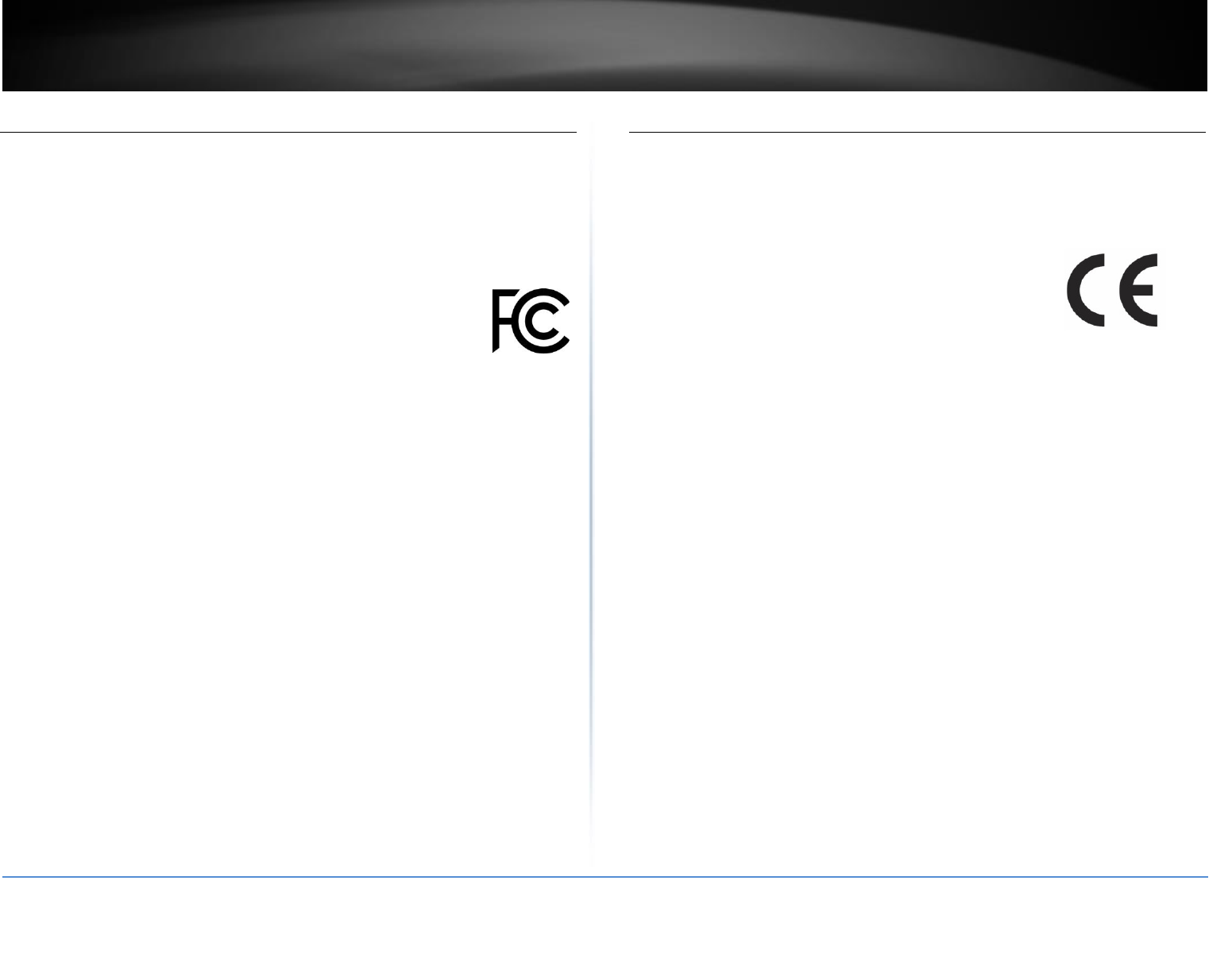
© Copyright 2015 TRENDnet. All Rights Reserved.
TRENDet User’s Guide
TEW-755AP
40
Federal Communication Commission Interference Statement
This equipment has been tested and found to comply with the limits for a Class B digital
device, pursuant to Part 15 of the FCC Rules. These limits are designed to provide reasonable
protection against harmful interference in a residential installation. This equipment
generates, uses and can radiate radio frequency energy and, if not installed and used in
accordance with the instructions, may cause harmful interference to radio communications.
However, there is no guarantee that interference will not occur in a particular installation. If
this equipment does cause harmful interference to radio or television reception, which can
be determined by turning the equipment off and on, the user is encouraged to try to correct
the interference by one of the following measures:
Reorient or relocate the receiving antenna.
Increase the separation between the equipment and receiver.
Connect the equipment into an outlet on a circuit different from that to which the
receiver is connected.
Consult the dealer or an experienced radio/TV technician for help.
FCC Caution: Any changes or modifications not expressly approved by the party responsible
for compliance could void the user's authority to operate this equipment.
This device complies with Part 15 of the FCC Rules. Operation is subject to the following two
conditions: (1) This device may not cause harmful interference, and (2) this device must
accept any interference received, including interference that may cause undesired
operation.
Operation of this device is restricted to indoor use only
IMPORTANT NOTE:
Radiation Exposure Statement:
This equipment complies with FCC radiation exposure limits set forth for an uncontrolled
environment. This equipment should be installed and operated with minimum distance
20cm between the radiator & your body.
This transmitter must not be co-located or operating in conjunction with any other antenna
or transmitter.
Country Code selection feature to be disabled for products marketed to the US/CANADA
Europe – EU Declaration of Conformity
TRENDnet hereby declare that the product is in compliance with the essential requirements
and other relevant provisions under our sole responsibility.
Safety
EN60950-1 : 2006 + A11 : 2009 + A1: 2010 + A12: 2011 + A2: 2013
EMC
EN 55022: 2010 + AC: 2011
EN 55024: 2010
EN 301 489-1 V1.9.2: 09-2011
EN 301 489-17 V2.2.1: 09-2012
Radio Spectrum & Health
EN 300 328 V1.9.1 : 2015-02
EN 62311 : 2008
Energy Efficiency
Regulation (EC) No. 1275/2008, Regulation, No. 278/2009, No. 801/2013
This product is herewith confirmed to comply with the Directives.
Directives
Low Voltage Directive 2006/95/EC
EMC Directive 2004/108/EC
R&TTE Directive 1999/5/EC
EMF Directive 199/519/EC
Ecodesign Directive 2009/125/EC
RoHS Directive 2011/65/EU
REACH Regulation (EC) No. 1907/2006
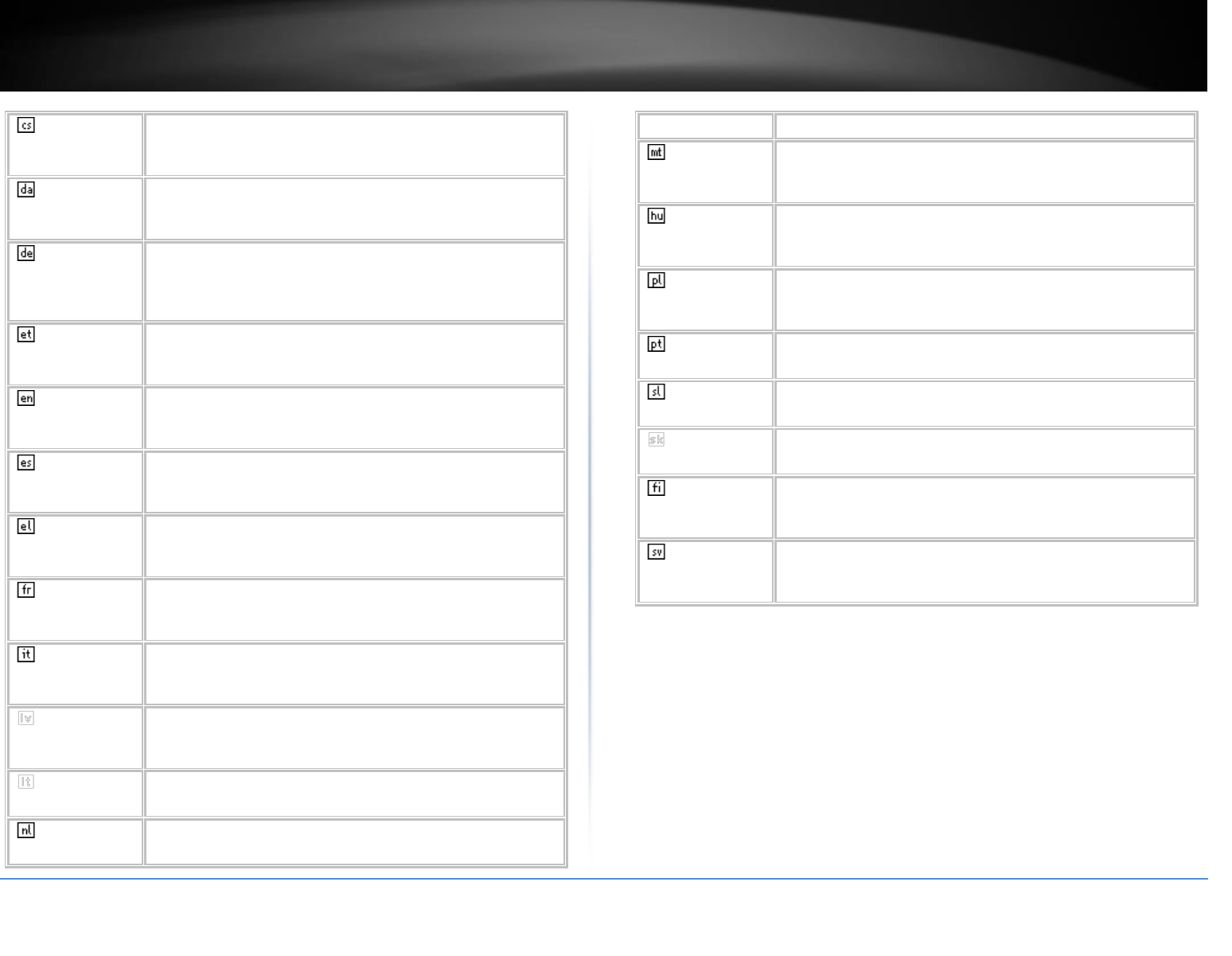
© Copyright 2015 TRENDnet. All Rights Reserved.
TRENDet User’s Guide
TEW-755AP
41
Česk [Czeh]
TRENDnet títo pohlašuje, že teto TEW-755AP je e shodě se
základíi požadak a dalšíi příslušýi ustaoeíi sěie
1999/5/ES.
Dansk [Danish]
Undertegnede TRENDnet erklærer herved, at følgende udstyr TEW-
755AP overholder de væsentlige krav og øvrige relevante krav i
direktiv 1999/5/EF.
Deutsch
[German]
Hiermit erklärt TRENDnet, dass sich das Gerät TEW-755AP in
Übereinstimmung mit den grundlegenden Anforderungen und den
übrigen einschlägigen Bestimmungen der Richtlinie 1999/5/EG
befindet.
Eesti [Estonian]
Käesolevaga kinnitab TRENDnet seadme TEW-755AP vastavust
direktiivi 1999/5/EÜ põhinõuetele ja nimetatud direktiivist
tulenevatele teistele asjakohastele sätetele.
English
Hereby, TRENDnet, declares that this TEW-755AP is in compliance
with the essential requirements and other relevant provisions of
Directive 1999/5/EC.
Español
[Spanish]
Por medio de la presente TRENDnet declara que el TEW-755AP
cumple con los requisitos esenciales y cualesquiera otras
disposiciones aplicables o exigibles de la Directiva 1999/5/CE.
ηνιή
[Greek]
Η ΑΑTREΠDet ΗΩΙ ΙTEW-755AP
ΩΑΙ Ι ΙΩΙ ΑΑΙΗΙ ΑΙ Ι Ι
Ι ΙΑΑΙ Η ΗΙΑ //.
Français
[French]
Par la présente TRENDnet déclare que l'appareil TEW-755AP est
conforme aux exigences essentielles et aux autres dispositions
pertinentes de la directive 1999/5/CE.
Italiano[Italian]
Con la presente TRENDnet dichiara che questo TEW-755AP è
conforme ai requisiti essenziali ed alle altre disposizioni pertinenti
stabilite dalla direttiva 1999/5/CE.
Latviski [Latvian]
AšoTREΠDetdeklaē, ka TEW-755AP deklaē, ka [tpe of euipet
/ iekātas tips] atilst Diektīas //EK ūtiskajā pasīā u
itie a to saistītajie oteikuie.
Κietuių
[Lithuanian]
Šiuo TREΠDet deklauoja, kad šis TEW-755AP atitinka esminius
reikalavimus ir kitas 1999/5/EB Direktyvos nuostatas.
Nederlands
[Dutch]
Hierbij verklaart TRENDnet dat het toestel TEW-755AP in
overeenstemming is met de essentiële eisen en de andere relevante
bepalingen van richtlijn 1999/5/EG.
Malti [Maltese]
Hawnhekk, TRENDnet, jiddikjara li dan TEW-755AP jikkonforma mal-
ħtiġijiet essezjali u a poedieti oħaj eleati li he fid-
Dirrettiva 1999/5/EC.
Magyar
[Hungarian]
Alulírott, TRENDnet nyilatkozom, hogy a TEW-755AP megfelel a
vonatkozó alapvetõ követelményeknek és az 1999/5/EC irányelv
egyéb elõírásainak.
Polski [Polish]
Πiiejsz TREΠDet ośiadza, że TEW-755AP ] jest zgodny z
zasadizi ogai oaz pozostałi stosoi
postanowieniami Dyrektywy 1999/5/EC.
Português
[Portuguese]
TRENDnet declara que este TEW-755AP está conforme com os
requisitos essenciais e outras disposições da Directiva 1999/5/CE.
Slovensko
[Slovenian]
TRENDnet izjavlja, da je ta TEW-755AP v skladu z bistvenimi
zahteai i ostalii eleatii določili diektie //E“.
Slovensky
[Slovak]
TRENDnettýmtovhlasuje, že TEW-755AP spĺňa základé požiadak
a šetk píslušé ustaoeia “eie //E“.
Suomi [Finnish]
TRENDnet vakuuttaa täten että TEW-755AP tyyppinen laite on
direktiivin 1999/5/EY oleellisten vaatimusten ja sitä koskevien
direktiivin muiden ehtojen mukainen.
Svenska
[Swedish]
Härmed intygar TRENDnet att denna TEW-755AP står I
överensstämmelse med de väsentliga egenskapskrav och övriga
relevanta bestämmelser som framgår av direktiv 1999/5/EG.

© Copyright 2015 TRENDnet. All Rights Reserved.
TRENDet User’s Guide
TEW-755AP
42
Industry Canada Statement
This device complies with Industry Canada license-exempt RSS standard(s). Operation is
subject to the following two conditions: (1) this device may not cause interference, and (2)
this device must accept any interference, including interference that may cause undesired
operation of the device.
Le présent appareil est conforme aux CNR d'Industrie Canada applicables aux appareils radio
exempts de licence. L'exploitation est autorisée aux deux conditions suivantes : (1) l'appareil
ne doit pas produire de brouillage, et (2) l'utilisateur de l'appareil doit accepter tout
brouillage radioélectrique subi, même si le brouillage est susceptible d'en compromettre le
fonctionnement.
Radiation Exposure Statement:
This equipment complies with IC radiation exposure limits set forth for an uncontrolled
environment. This equipment should be installed and operated with minimum distance
20cm between the radiator & your body.
Déclaration d'exposition aux radiations:
Cet équipement est conforme aux limites d'exposition aux rayonnements IC établies pour un
environnement non contrôlé. Cet équipement doit être installé et utilisé avec un minimum
de 20 cm de distance entre la source de rayonnement et votre corps.

© Copyright 2015 TRENDnet. All Rights Reserved.
TRENDet User’s Guide
TEW-755AP
43
Limited Warranty
TRENDnet warrants its products against defects in material and workmanship, under
normal use and service, for the following lengths of time from the date of purchase.
TEW-755AP – 3 Years Warranty
AC/DC Power Adapter, Cooling Fan, and Power Supply carry 1 year warranty.
If a product does not operate as warranted during the applicable warranty period,
TRENDnet shall reserve the right, at its expense, to repair or replace the defective
product or part and deliver an equivalent product or part to the customer. The
epai/eplaeet uit’s aat otiues from the original date of purchase. All
products that are replaced become the property of TRENDnet. Replacement products
may be new or reconditioned. TRENDnet does not issue refunds or credit. Please
contact the point-of-purchase for their return policies.
TRENDnet shall not be responsible for any software, firmware, information, or memory
data of customer contained in, stored on, or integrated with any products returned to
TRENDnet pursuant to any warranty.
There are no user serviceable parts inside the product. Do not remove or attempt to
service the product by any unauthorized service center. This warranty is voided if (i) the
product has been modified or repaired by any unauthorized service center, (ii) the
product was subject to accident, abuse, or improper use (iii) the product was subject to
conditions more severe than those specified in the manual.
Warranty service may be obtained by contacting TRENDnet within the applicable
warranty period and providing a copy of the dated proof of the purchase. Upon proper
submission of required documentation a Return Material Authorization (RMA) number
will be issued. An RMA number is required in order to initiate warranty service support
for all TRENDnet products. Products that are sent to TRENDnet for RMA service must
have the RMA number marked on the outside of return packages and sent to TRENDnet
prepaid, insured and packaged appropriately for safe shipment. Customers shipping
from outside of the USA and Canada are responsible for return shipping fees. Customers
shipping from outside of the USA are responsible for custom charges, including but not
limited to, duty, tax, and other fees.
WARRANTIES EXCLUSIVE: IF THE TRENDNET PRODUCT DOES NOT OPERATE AS
WARRAΠTED ABOVE, THE CU“TOMER’“ “OΚE REMEDY “HAΚΚ BE, AT TREΠDΠET’“
OPTION, REPAIR OR REPLACE. THE FOREGOING WARRANTIES AND REMEDIES ARE
EXCLUSIVE AND ARE IN LIEU OF ALL OTHER WARRANTIES, EXPRESSED OR IMPLIED,
EITHER IN FACT OR BY OPERATION OF LAW, STATUTORY OR OTHERWISE, INCLUDING
WARRANTIES OF MERCHANTABILITY AND FITNESS FOR A PARTICULAR PURPOSE.
TRENDNET NEITHER ASSUMES NOR AUTHORIZES ANY OTHER PERSON TO ASSUME FOR
IT ANY OTHER LIABILITY IN CONNECTION WITH THE SALE, INSTALLATION MAINTENANCE
OR U“E OF TREΠDΠET’“ PRODUCT“.
TRENDNET SHALL NOT BE LIABLE UNDER THIS WARRANTY IF ITS TESTING AND
EXAMINATION DISCLOSE THAT THE ALLEGED DEFECT IN THE PRODUCT DOES NOT EXIST
OR WA“ CAU“ED BY CU“TOMER’“ OR AΠY THIRD PER“OΠ’“ MI“U“E, ΠEGΚECT,
IMPROPER INSTALLATION OR TESTING, UNAUTHORIZED ATTEMPTS TO REPAIR OR
MODIFY, OR ANY OTHER CAUSE BEYOND THE RANGE OF THE INTENDED USE, OR BY
ACCIDENT, FIRE, LIGHTNING, OR OTHER HAZARD.
LIMITATION OF LIABILITY: TO THE FULL EXTENT ALLOWED BY LAW TRENDNET ALSO
EXCLUDES FOR ITSELF AND ITS SUPPLIERS ANY LIABILITY, WHETHER BASED IN
CONTRACT OR TORT (INCLUDING NEGLIGENCE), FOR INCIDENTAL, CONSEQUENTIAL,
INDIRECT, SPECIAL, OR PUNITIVE DAMAGES OF ANY KIND, OR FOR LOSS OF REVENUE OR
PROFITS, LOSS OF BUSINESS, LOSS OF INFORMATION OR DATE, OR OTHER FINANCIAL
LOSS ARISING OUT OF OR IN CONNECTION WITH THE SALE, INSTALLATION,
MAINTENANCE, USE, PERFORMANCE, FAILURE, OR INTERRUPTION OF THE POSSIBILITY
OF SUCH DAMAGES, AND LIMITS ITS LIABILITY TO REPAIR, REPLACEMENT, OR REFUND
OF THE PURCHA“E PRICE PAID, AT TREΠDΠET’“ OPTIOΠ. THI“ DI“CΚAIMER OF ΚIABIΚITY
FOR DAMAGES WILL NOT BE AFFECTED IF ANY REMEDY PROVIDED HEREIN SHALL FAIL
OF ITS ESSENTIAL PURPOSE.
Governing Law: This Limited Warranty shall be governed by the laws of the state of
California.
Some TRENDnet products include software code written by third party developers.
These codes are subject to the GNU General Public License ("GPL") or GNU Lesser
General Public License ("LGPL").
Go to http://www.trendnet.com/gpl or http://www.trendnet.com Download section
and look for the desired TRENDnet product to access to the GPL Code or LGPL Code.
These codes are distributed WITHOUT WARRANTY and are subject to the copyrights of
the developers. TRENDnet does not provide technical support for these codes. Please go
to http://www.gnu.org/licenses/gpl.txt or http://www.gnu.org/licenses/lgpl.txt for
specific terms of each license.
PWP05202009v2 2015/18/9
